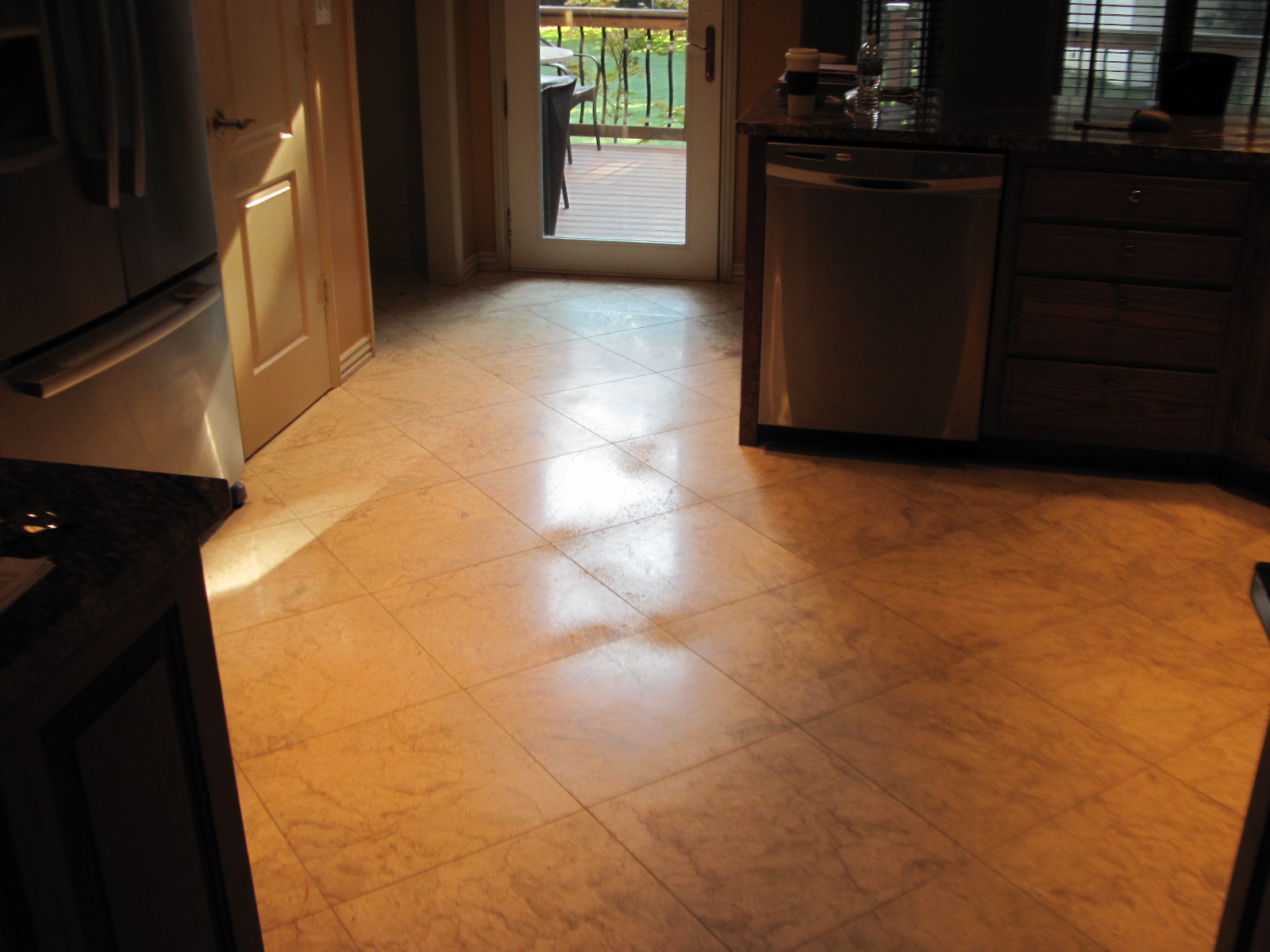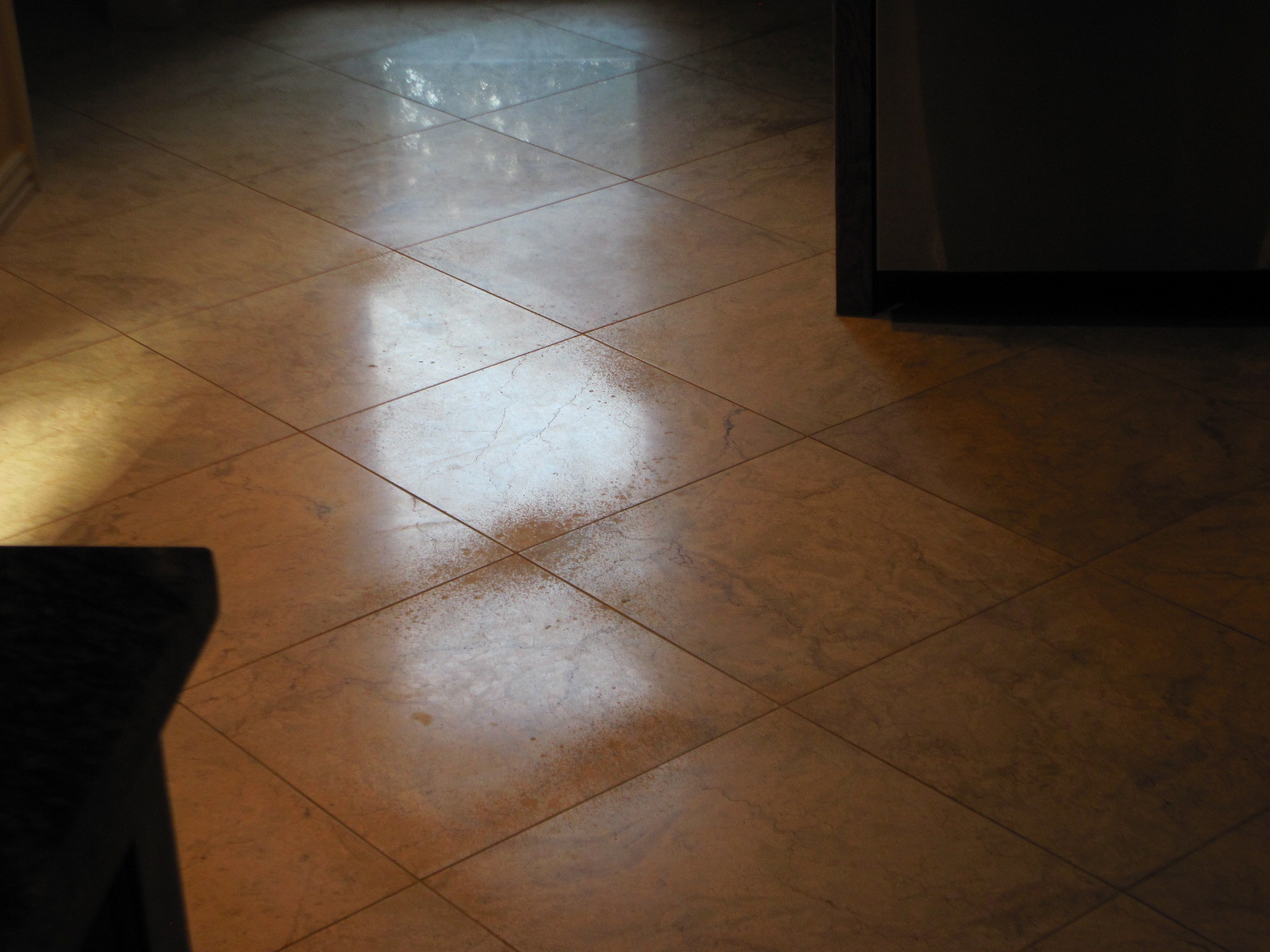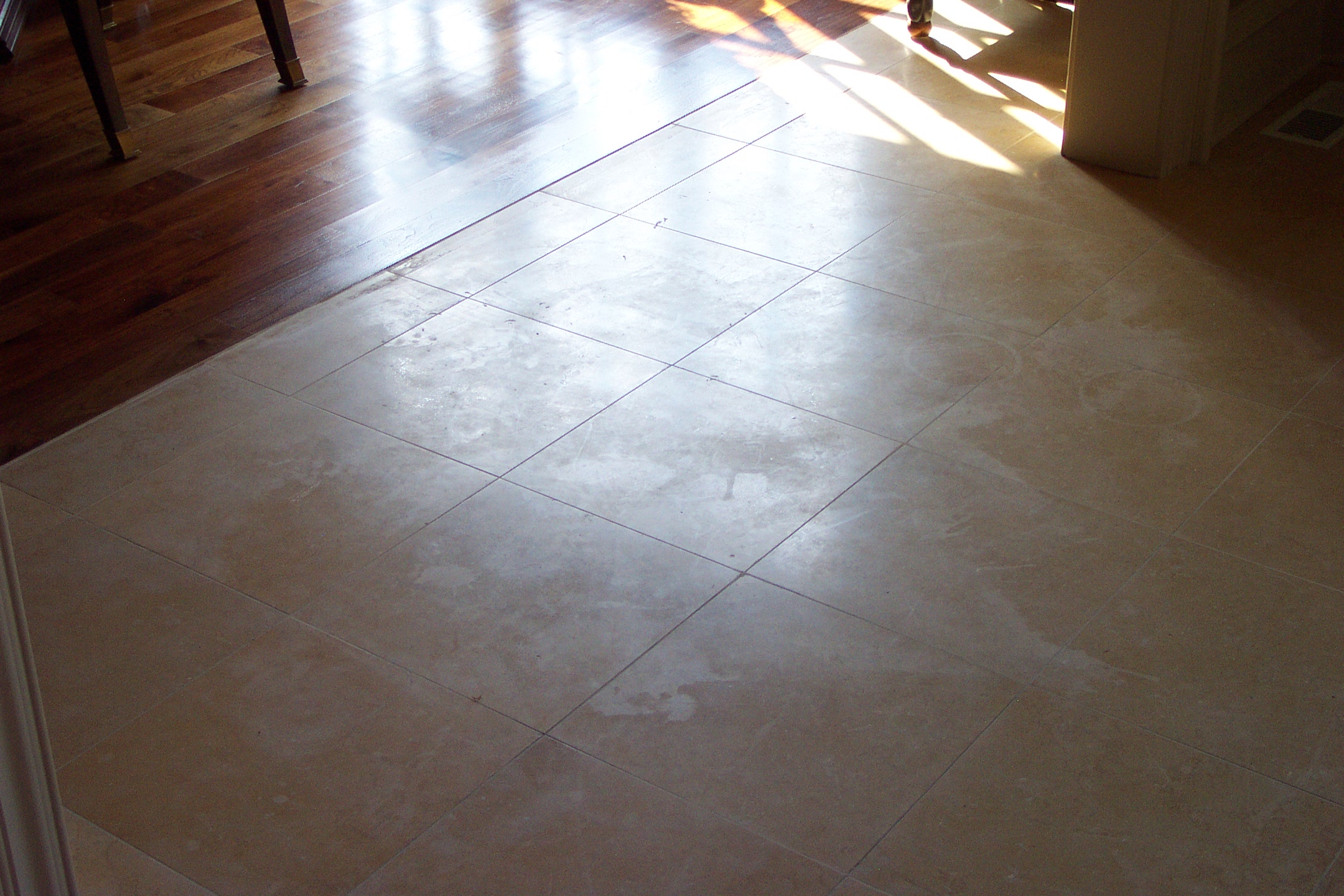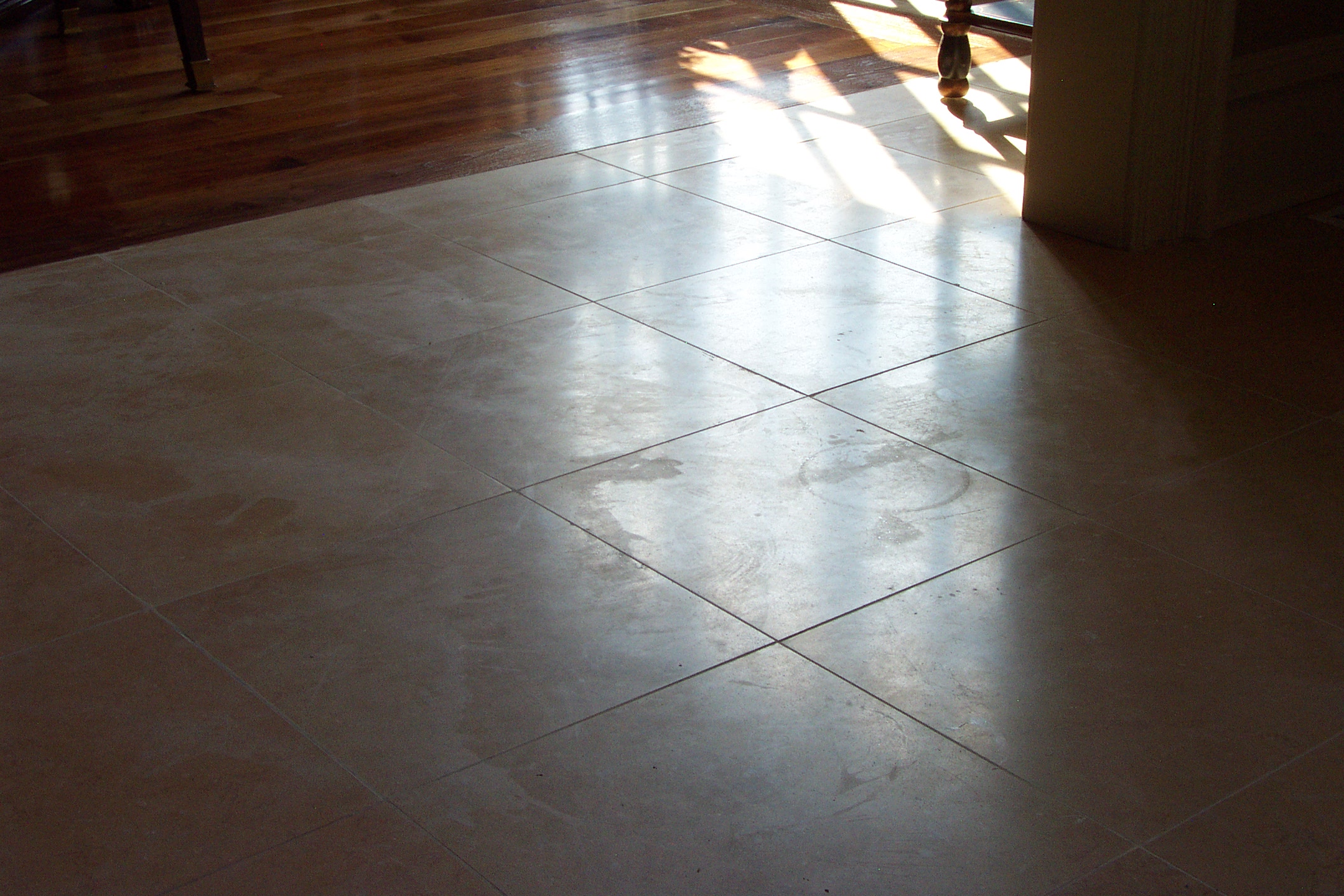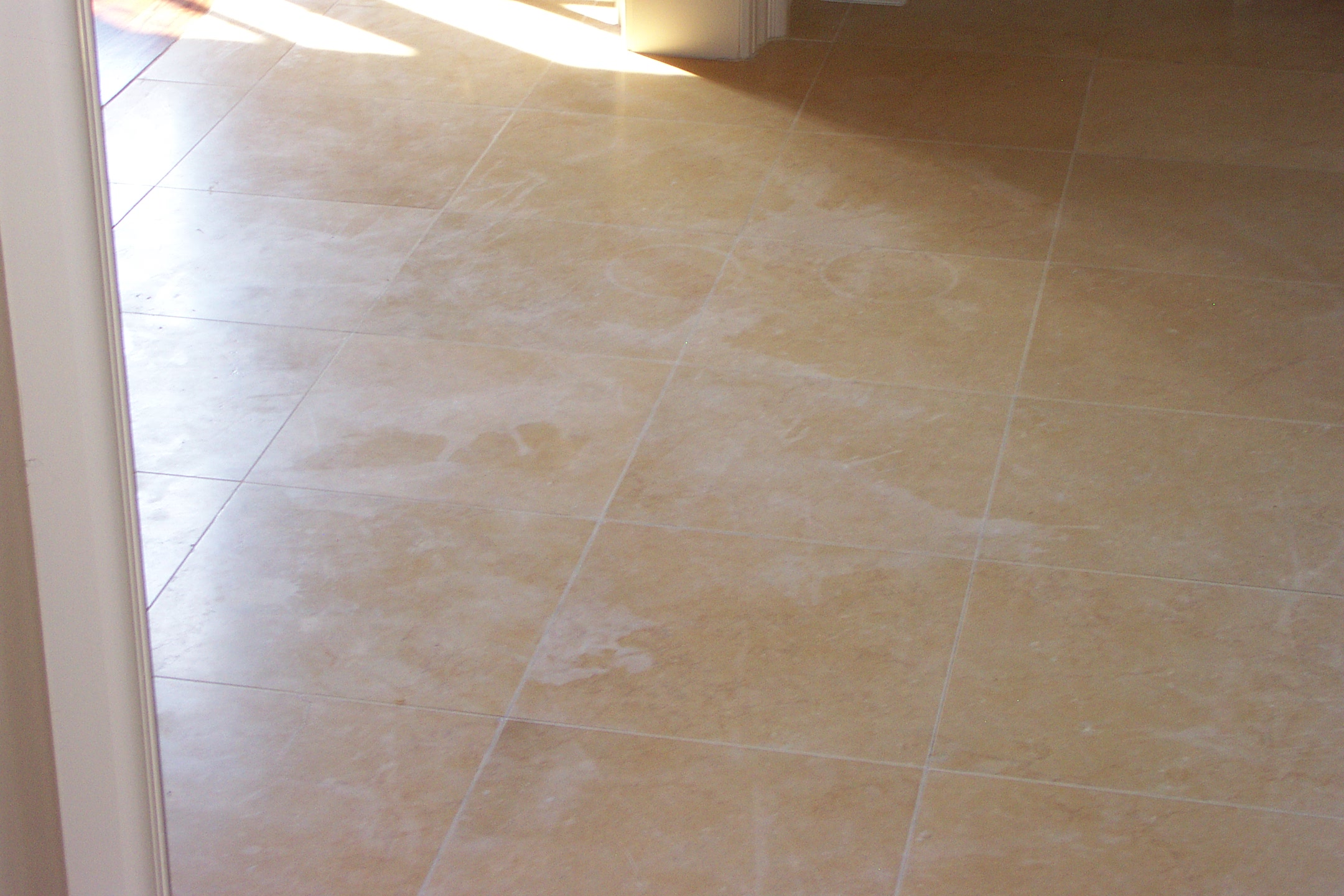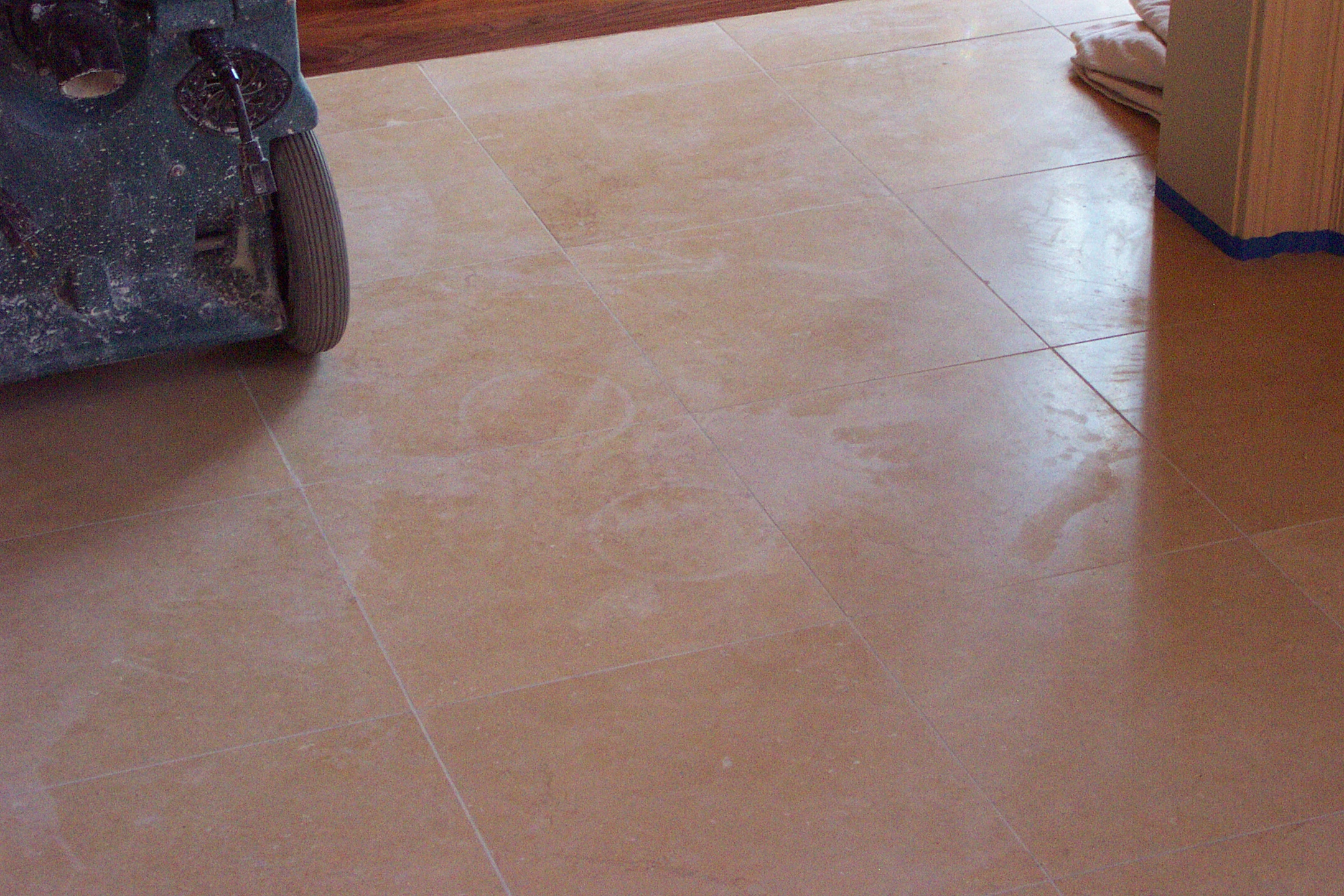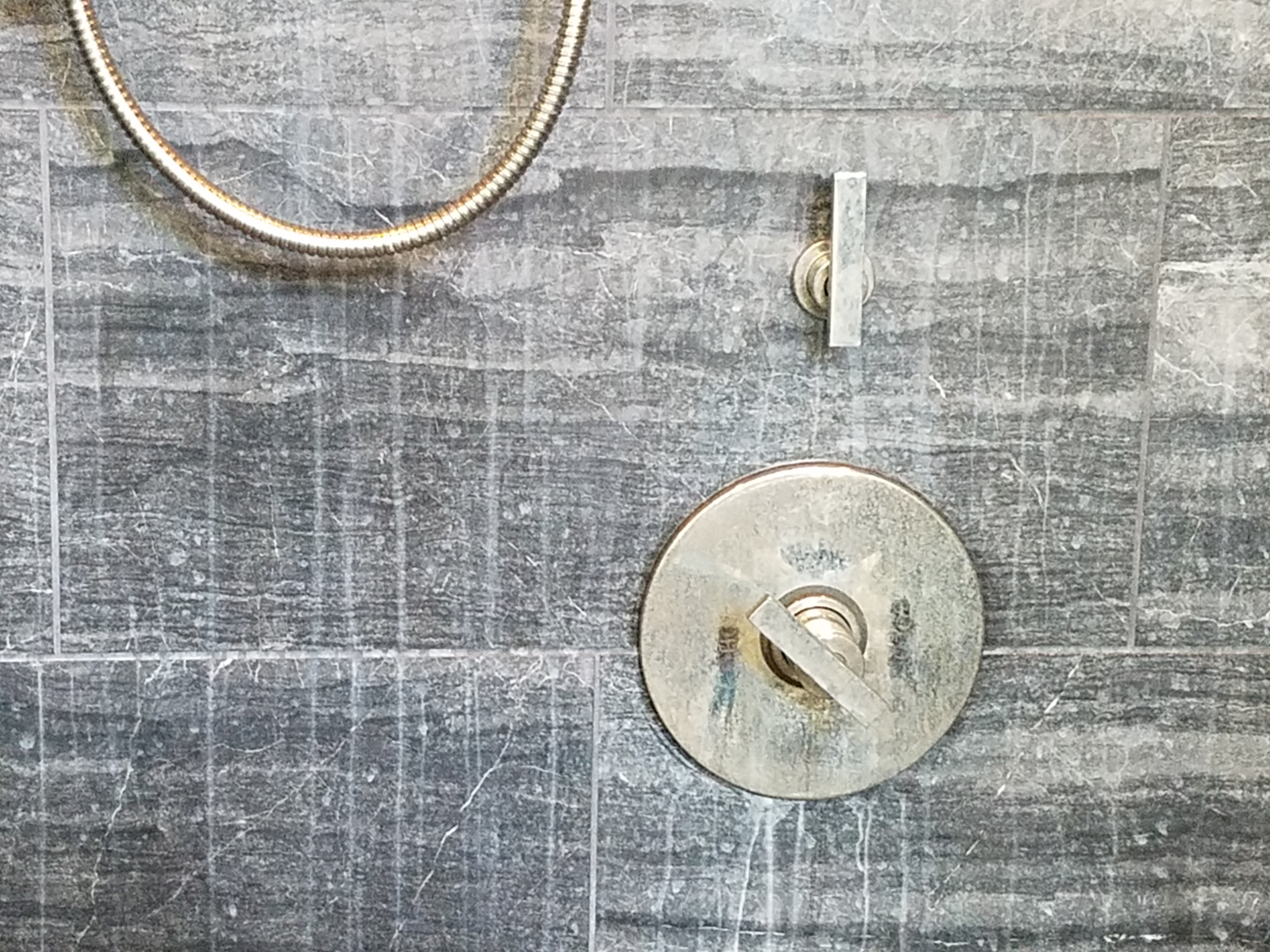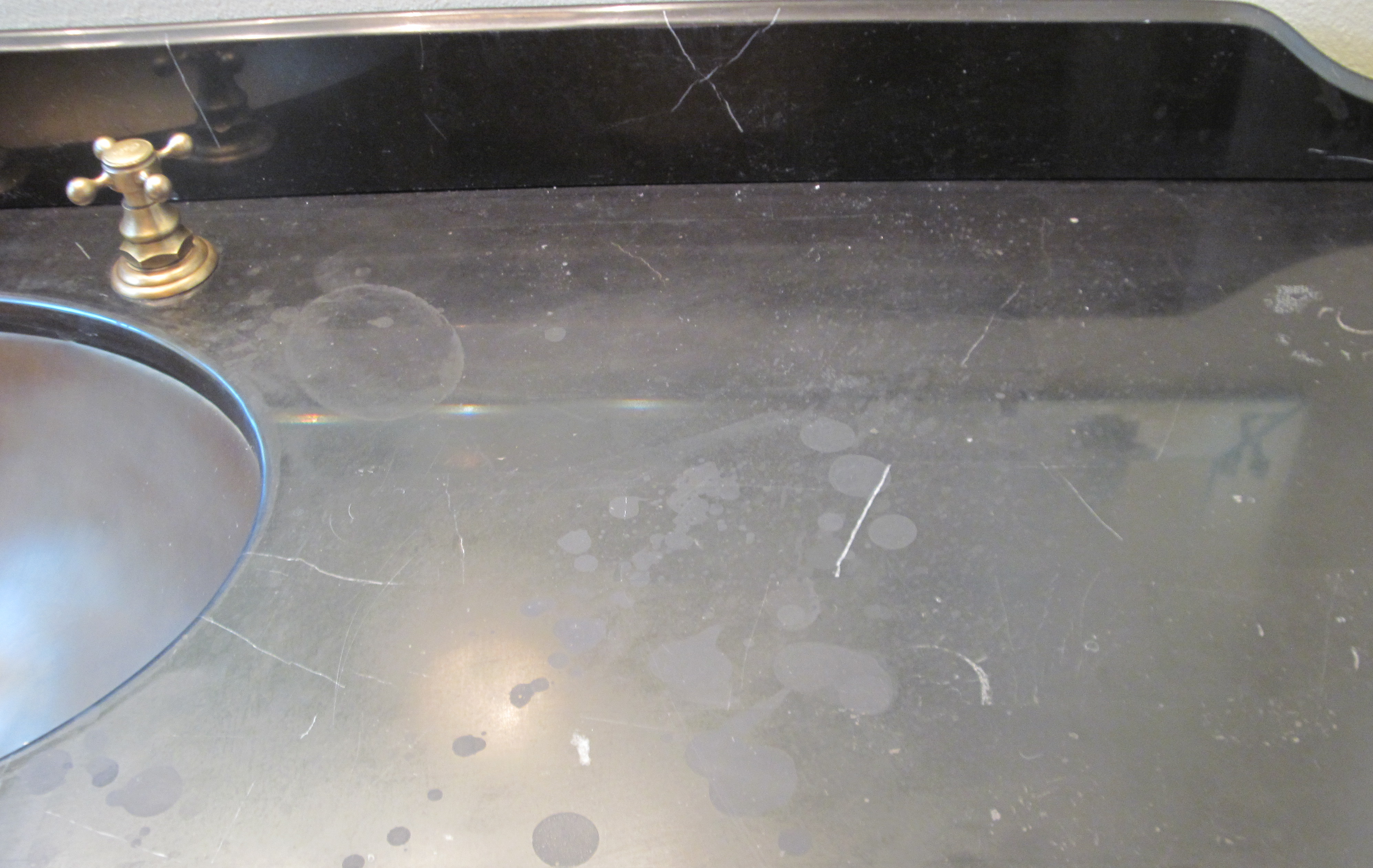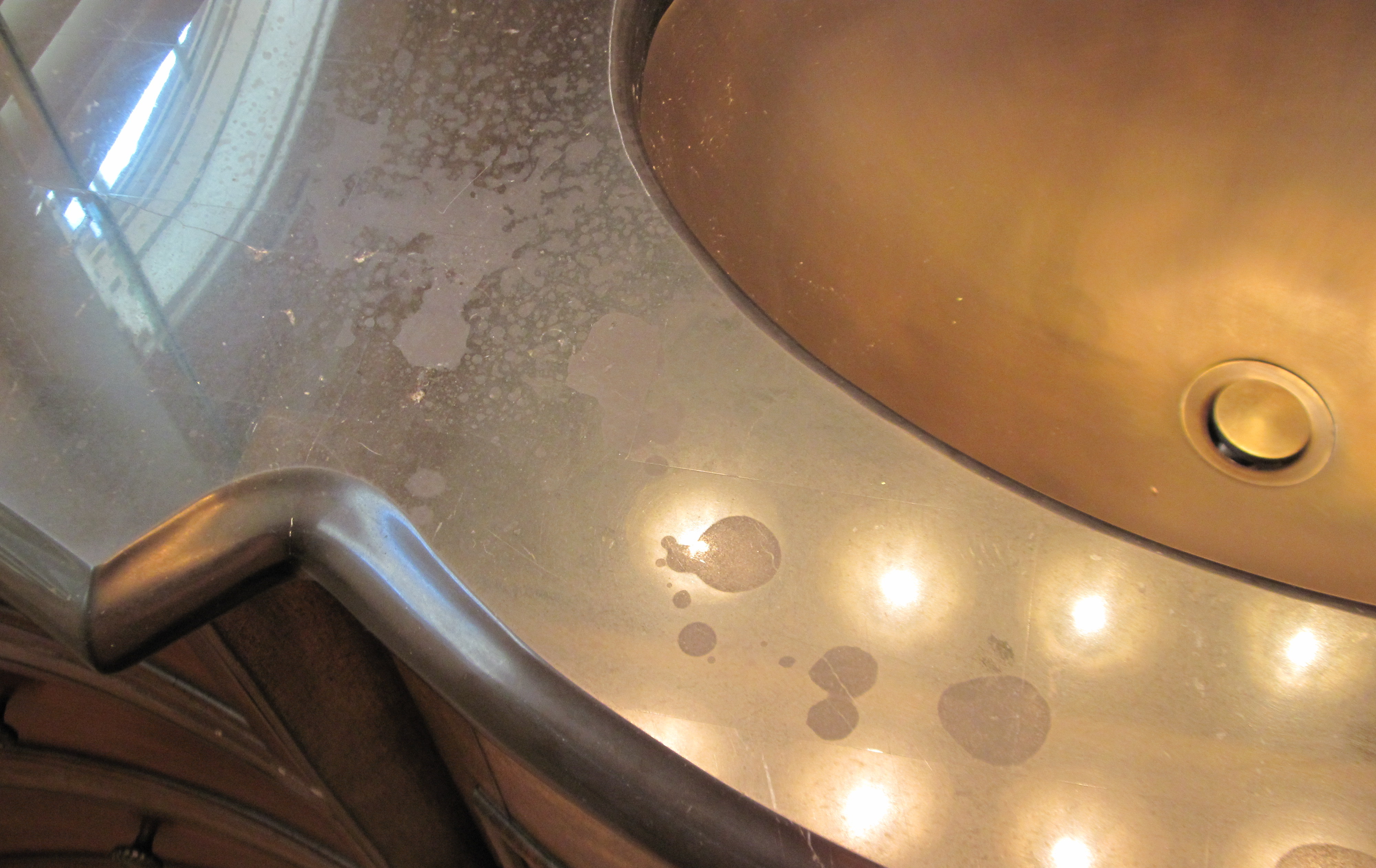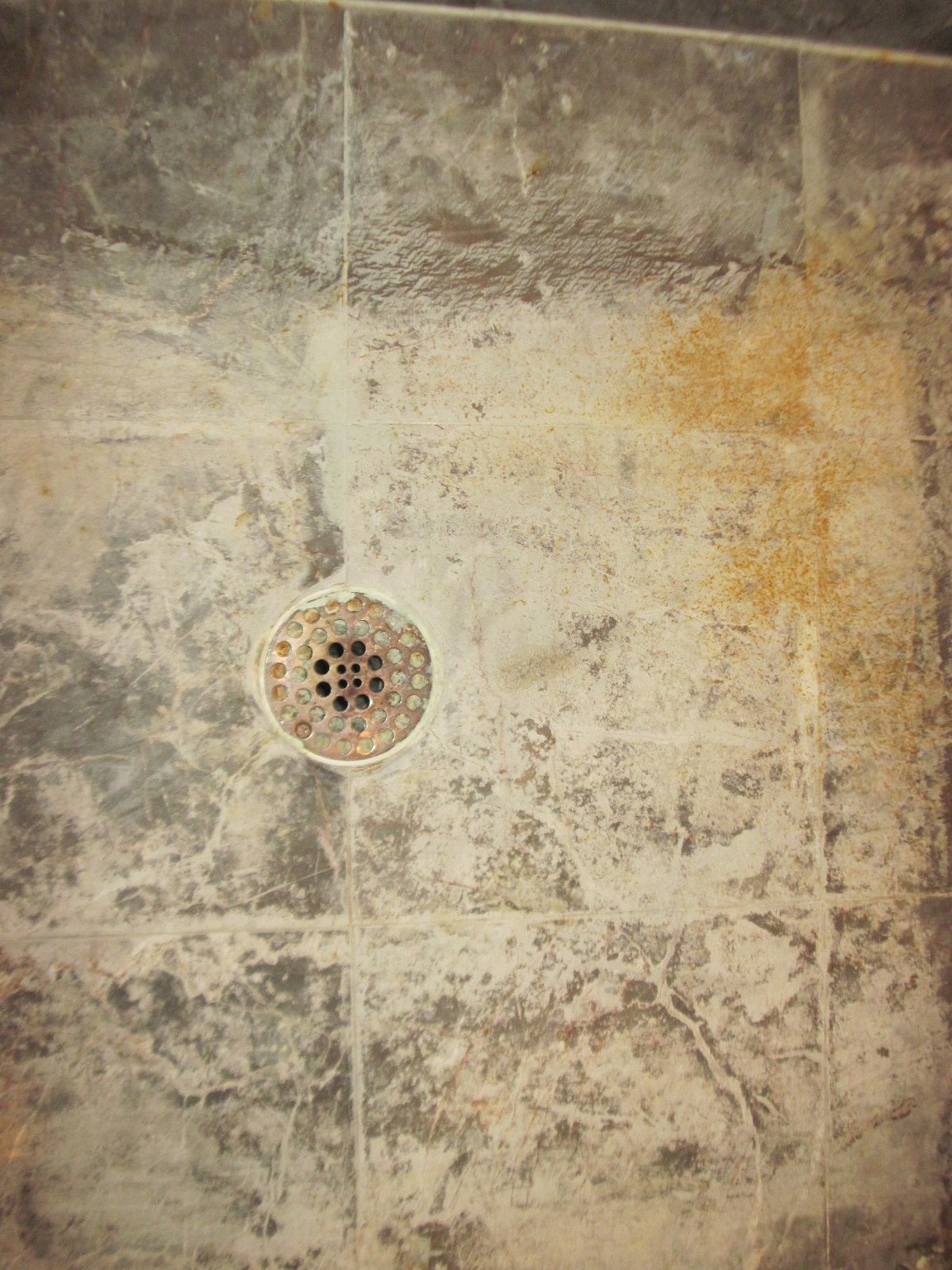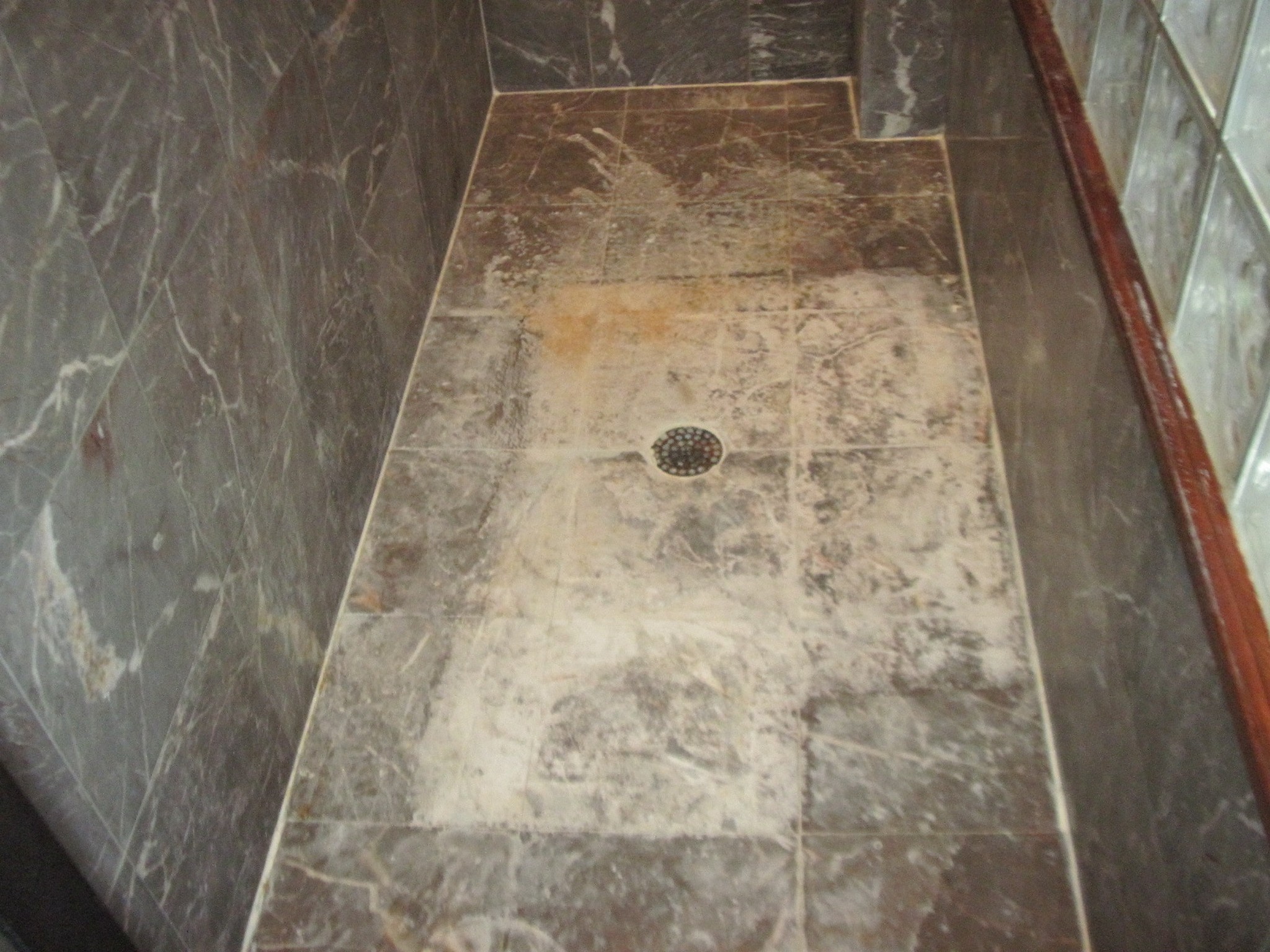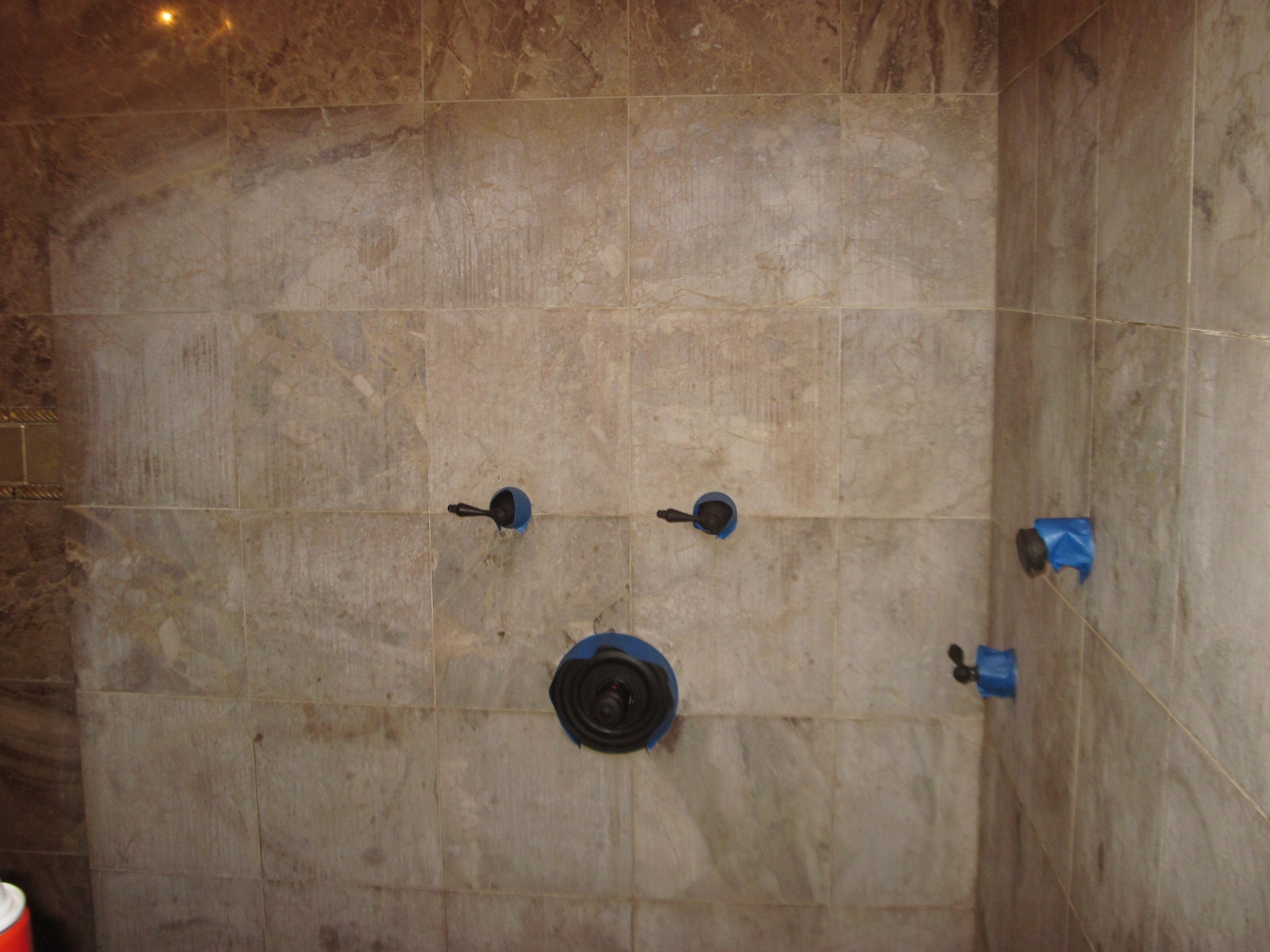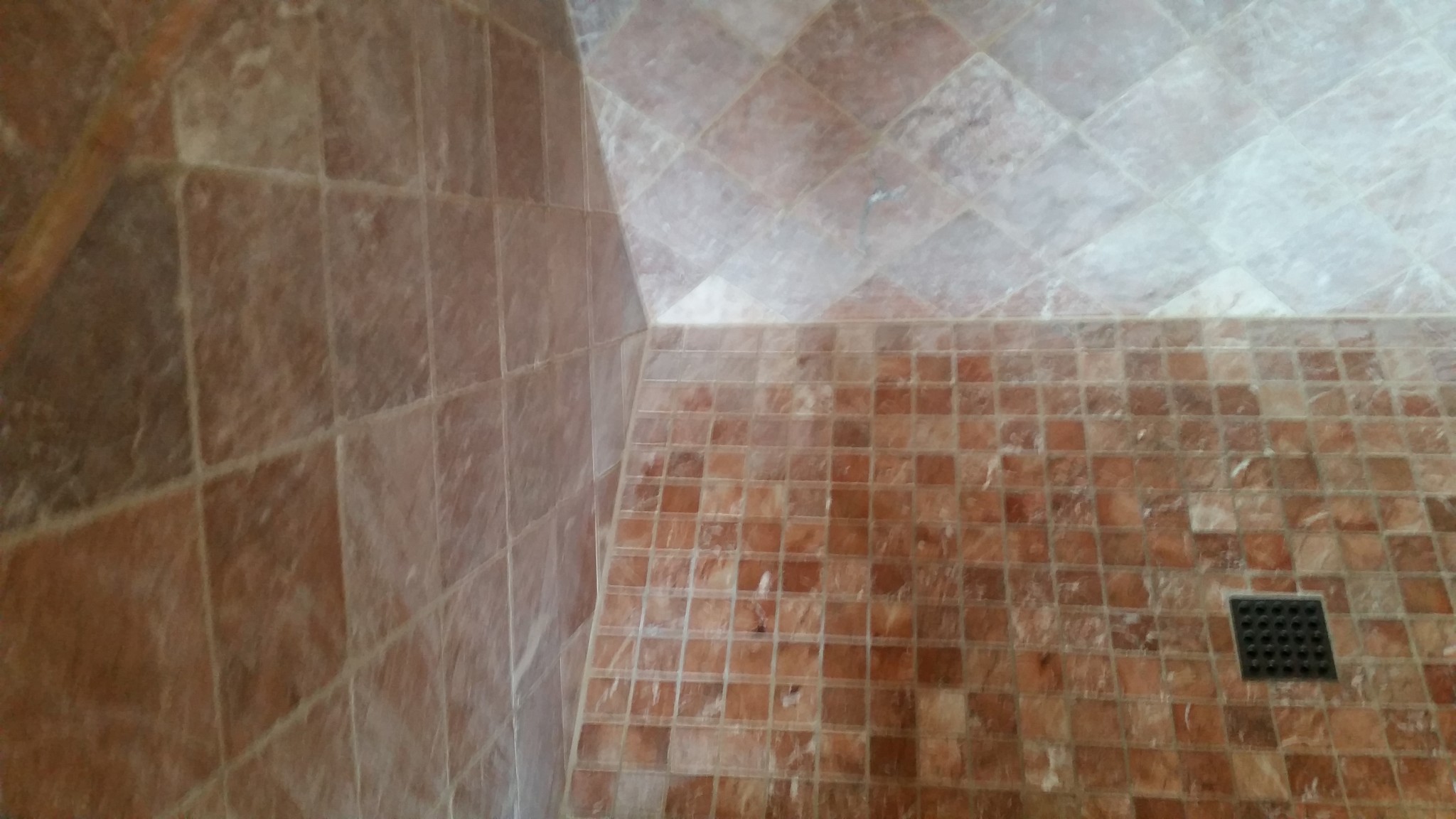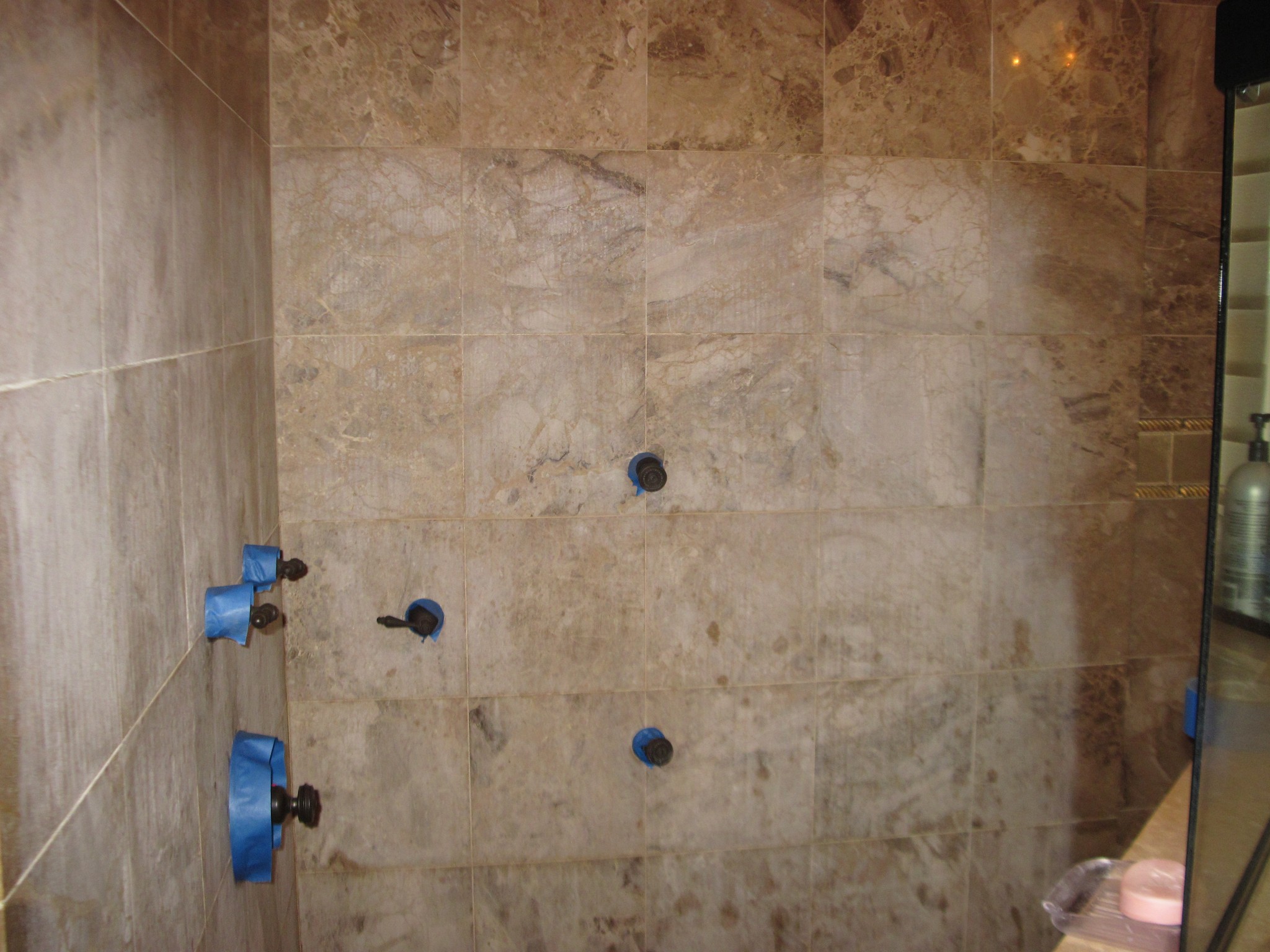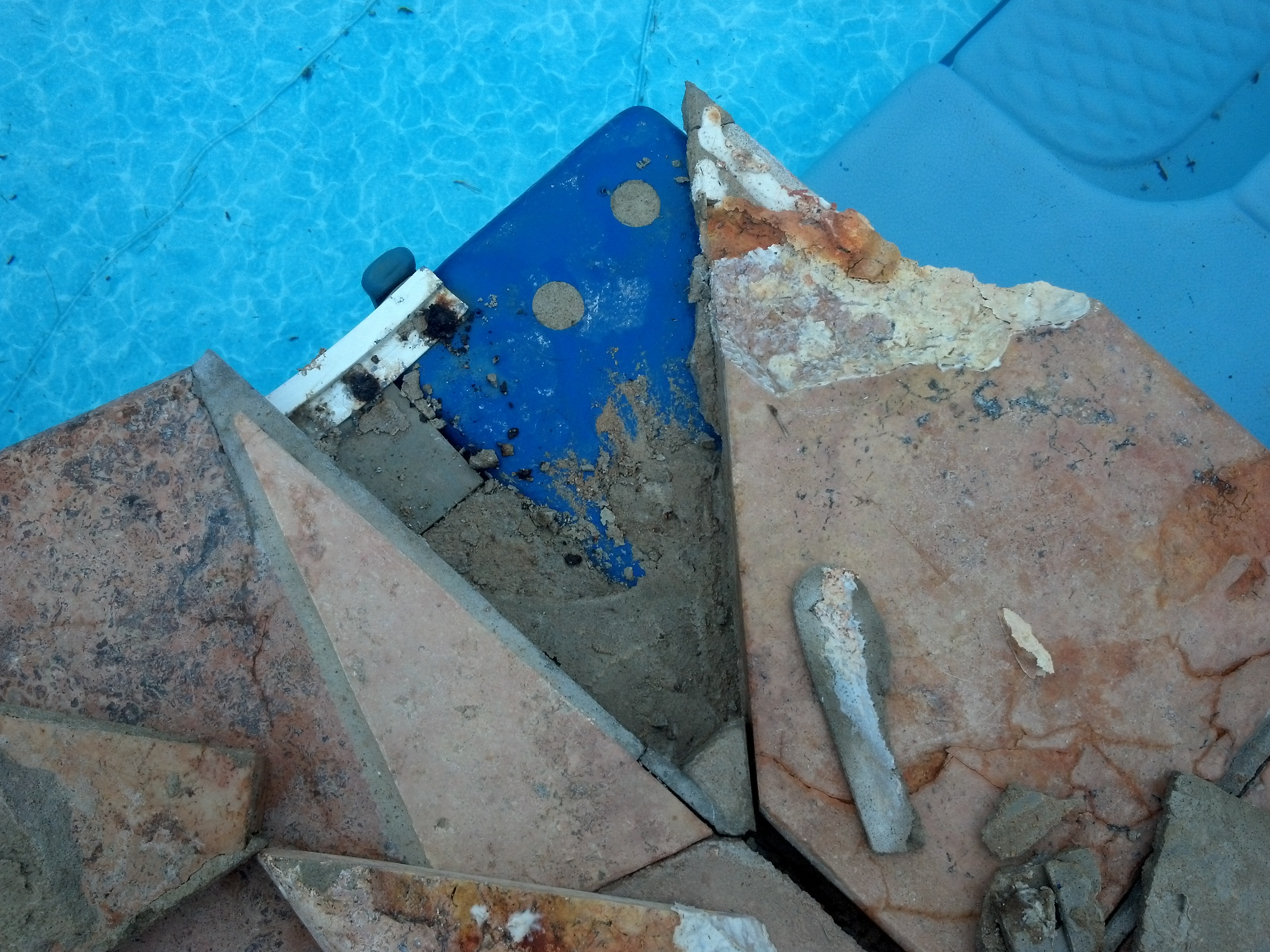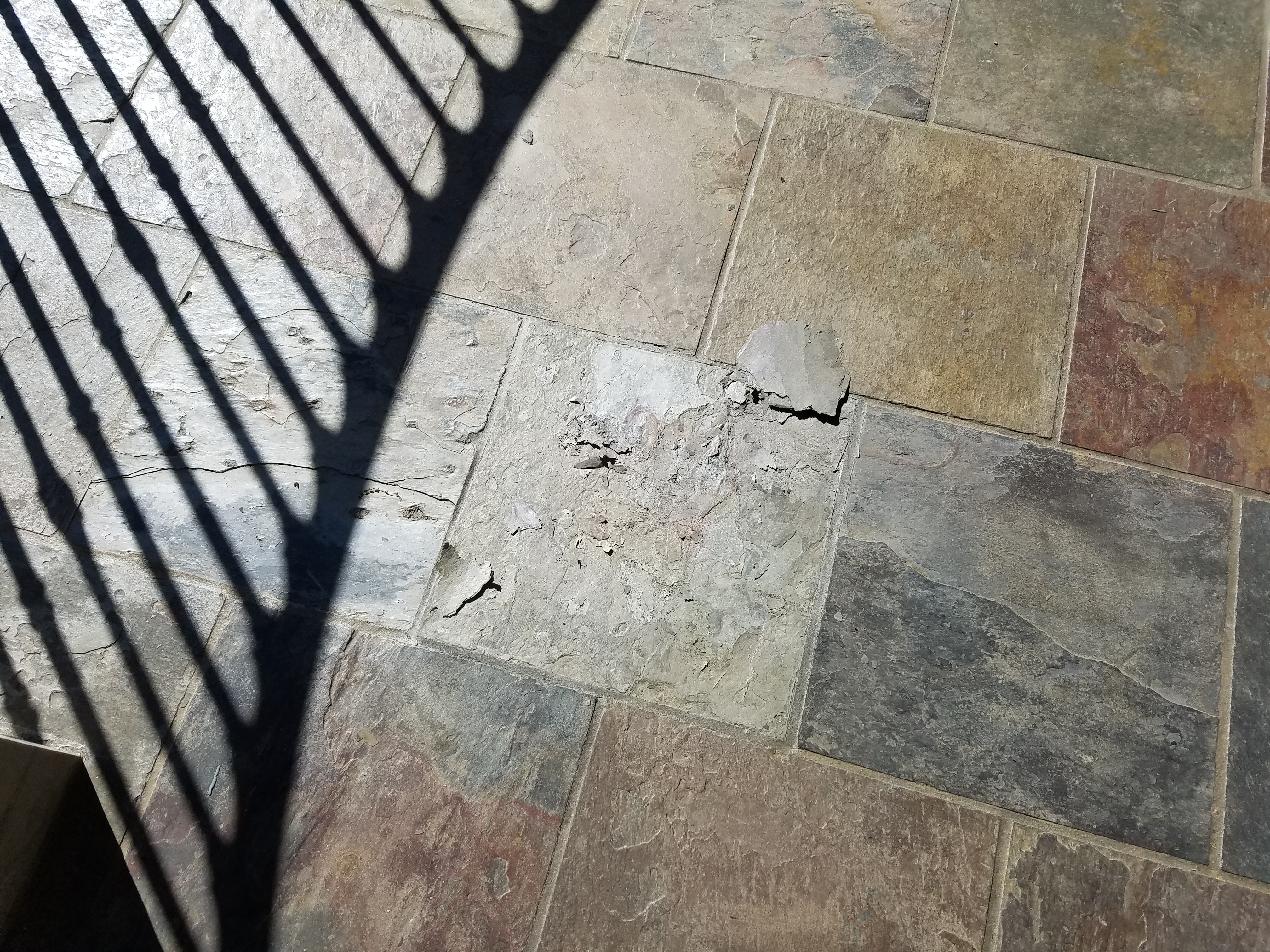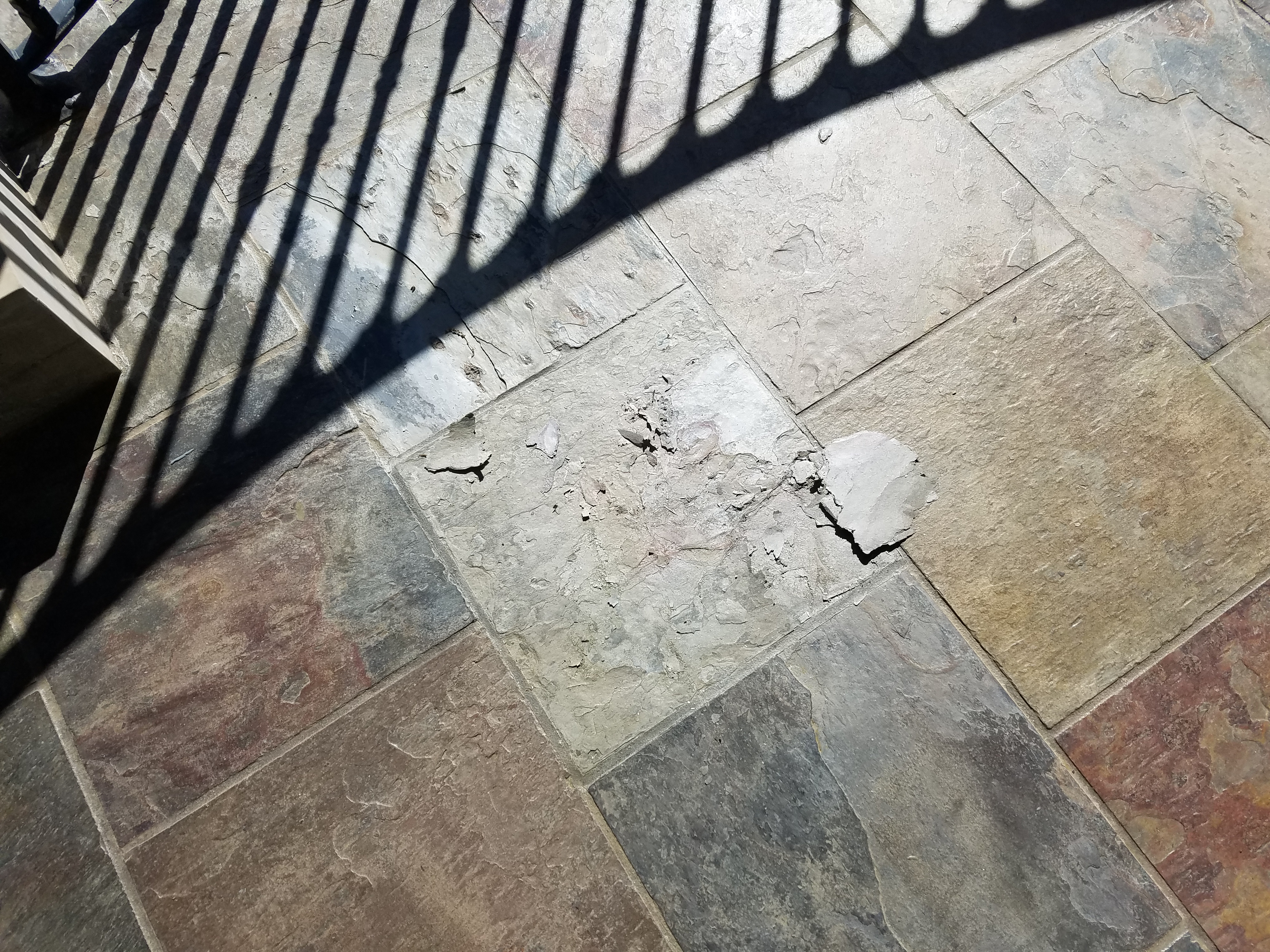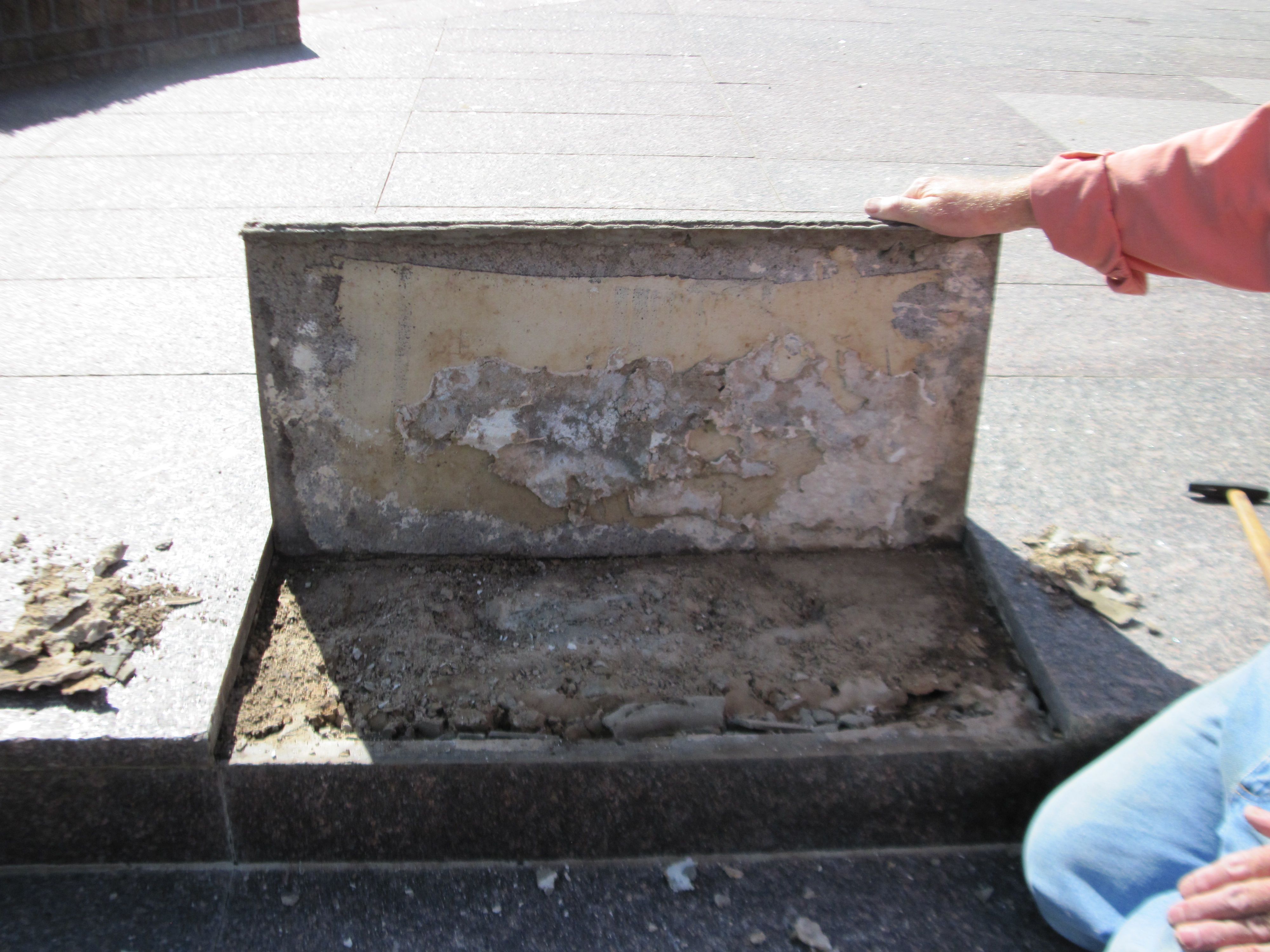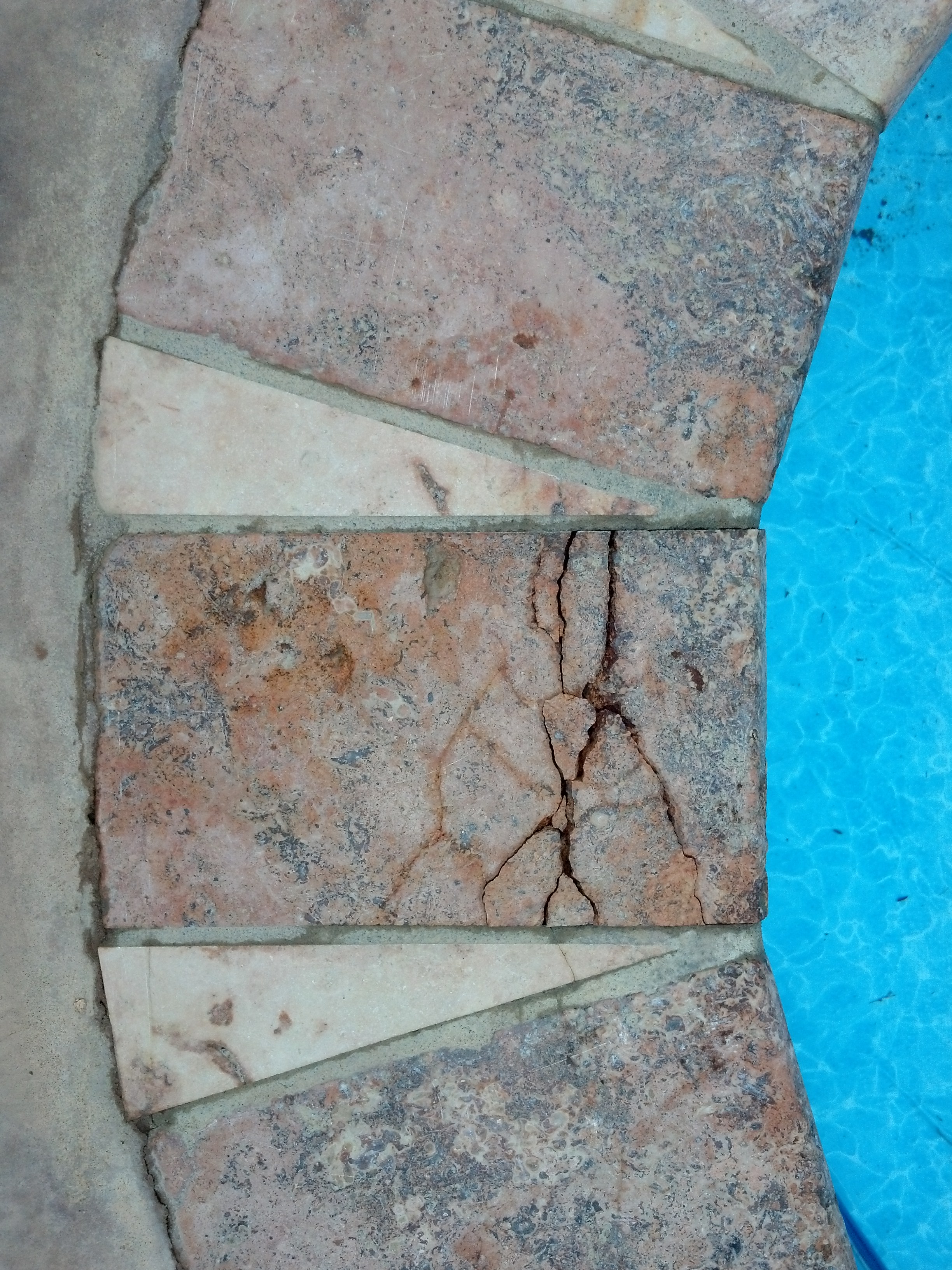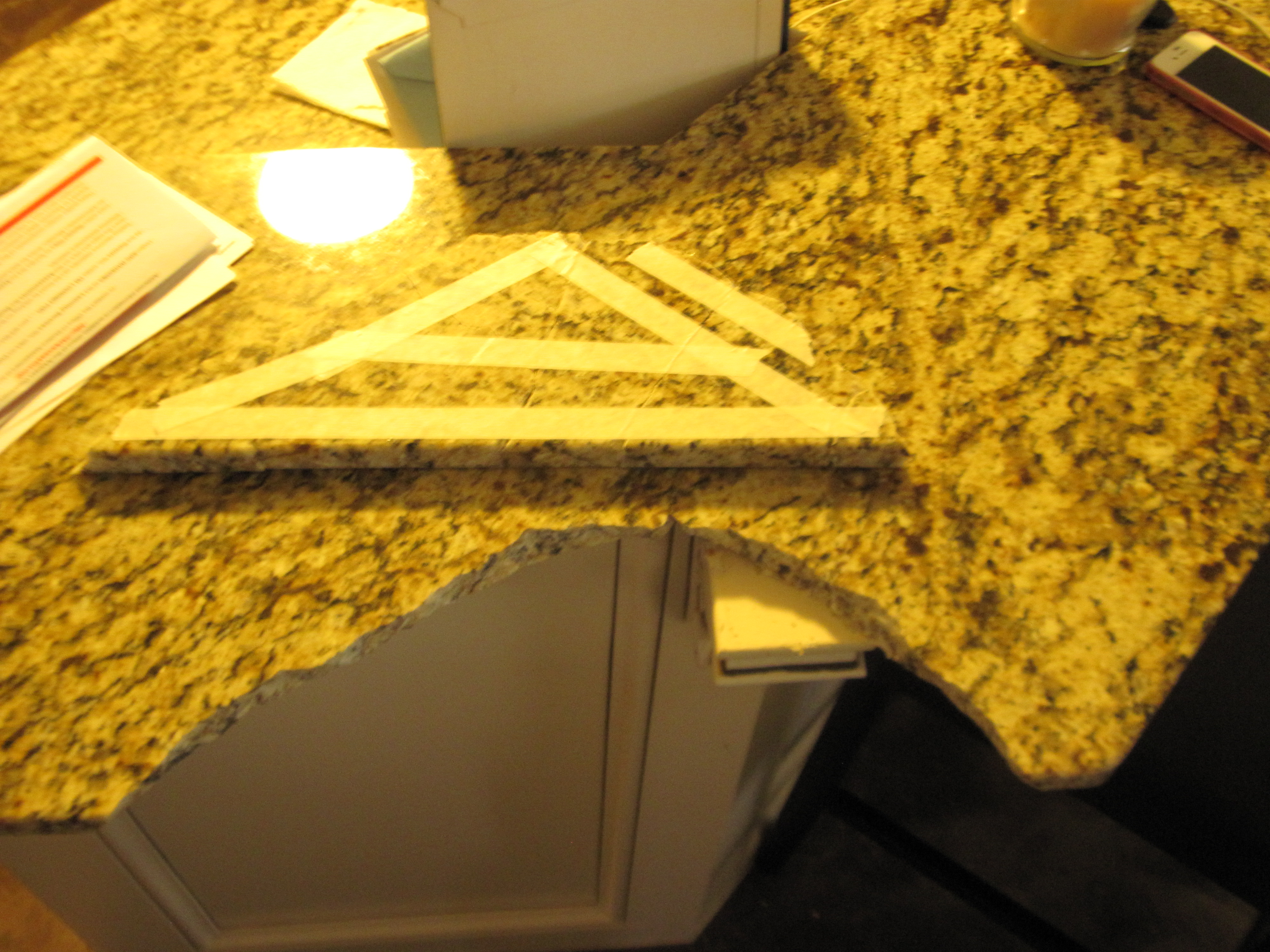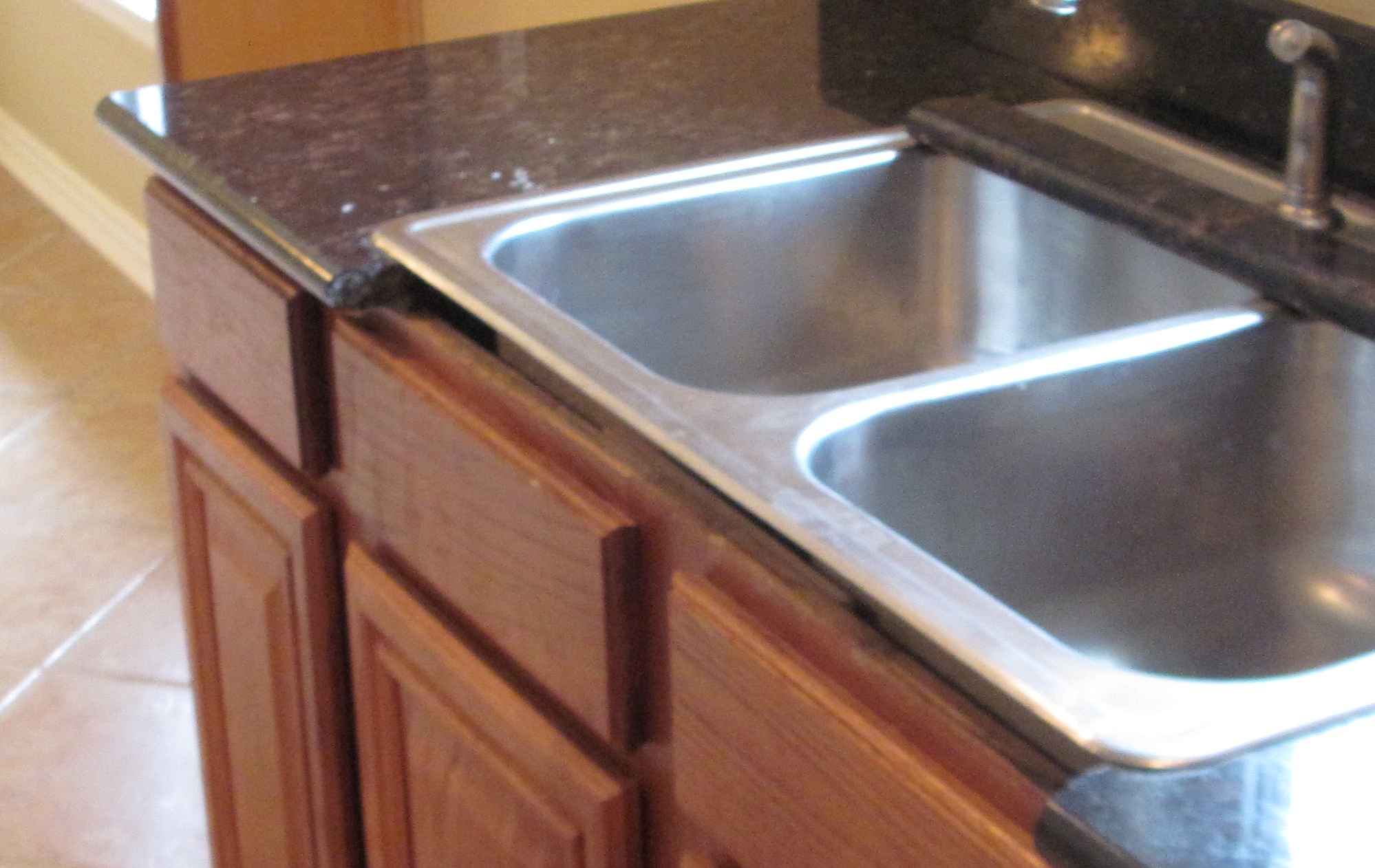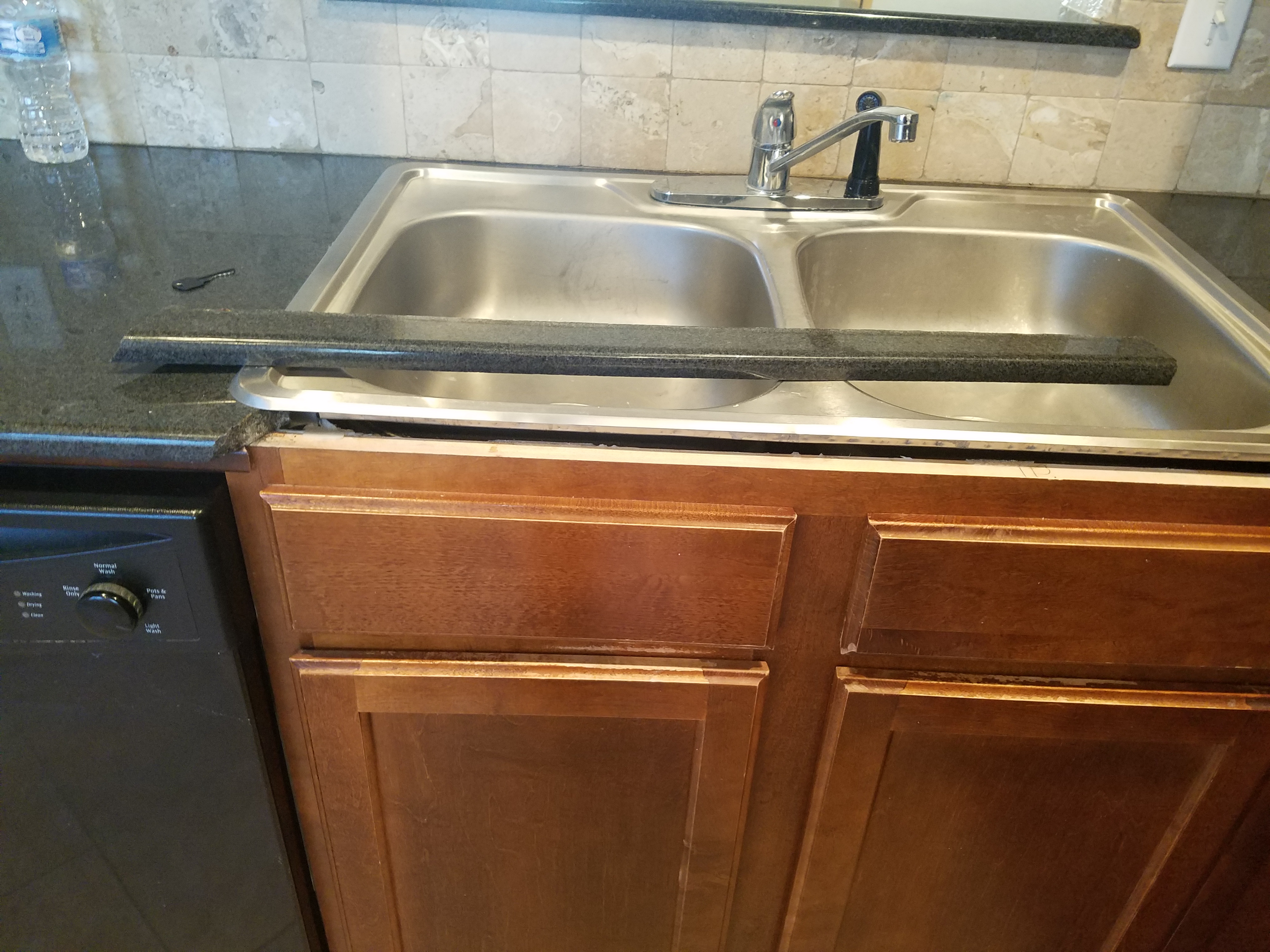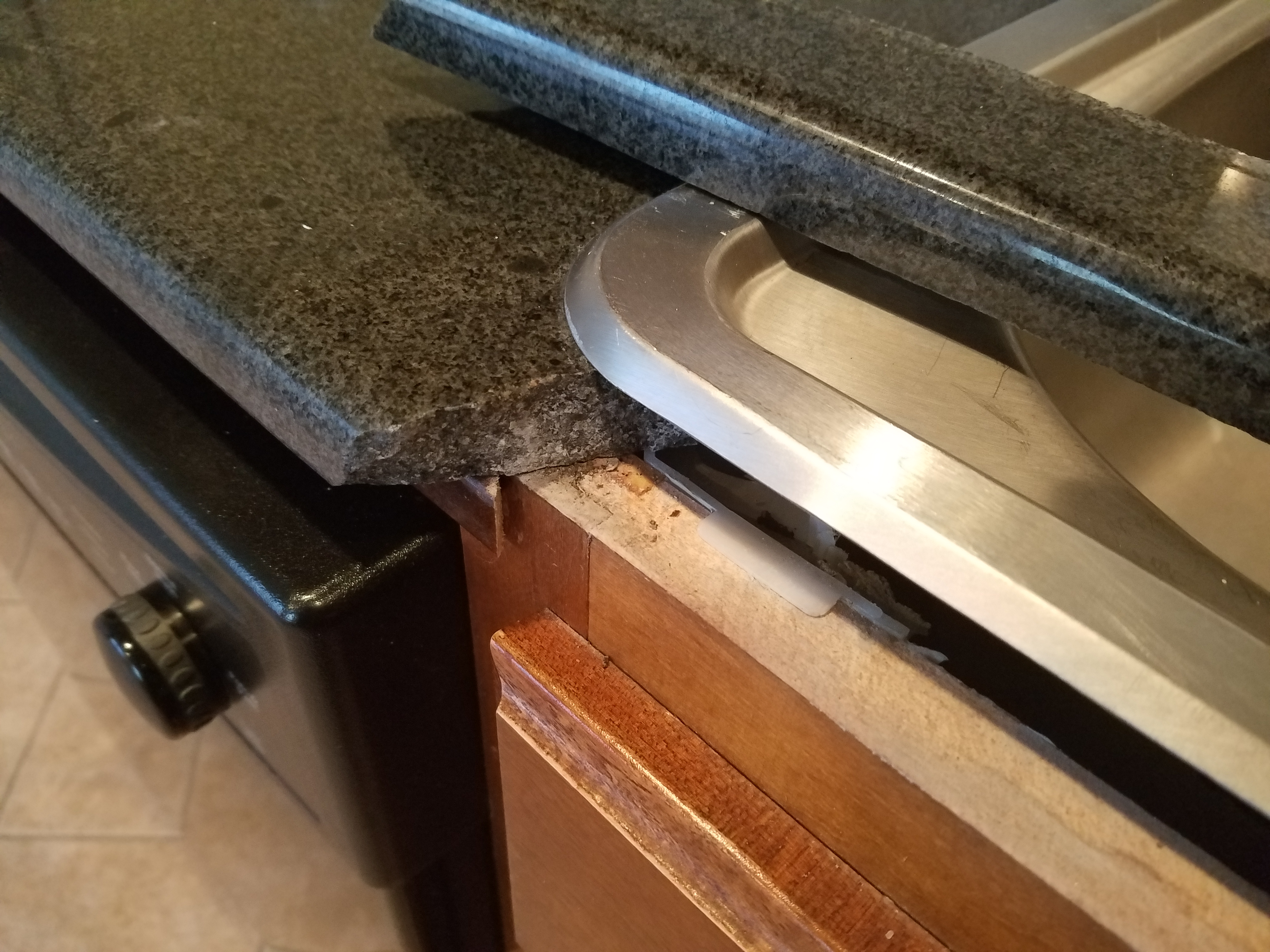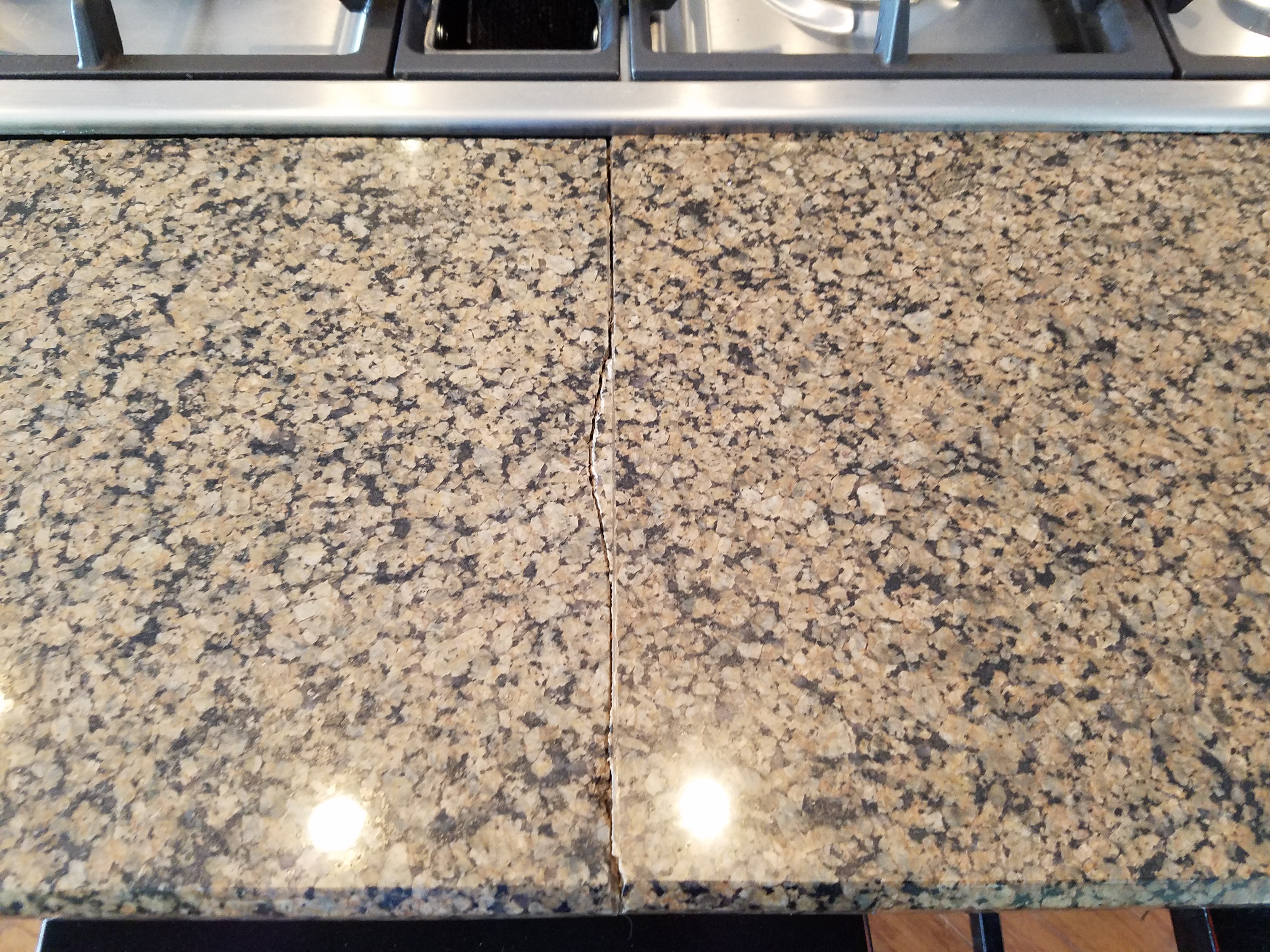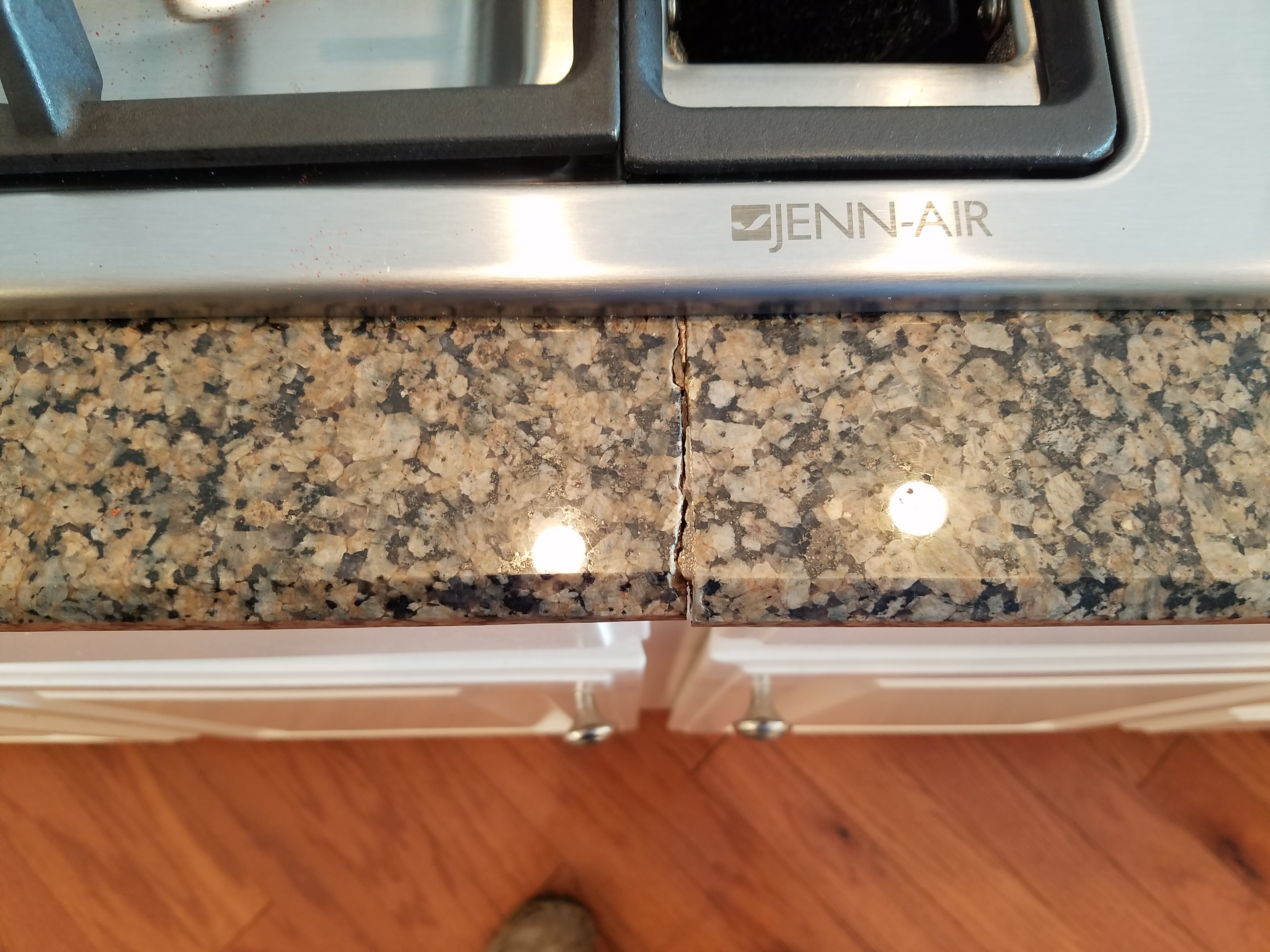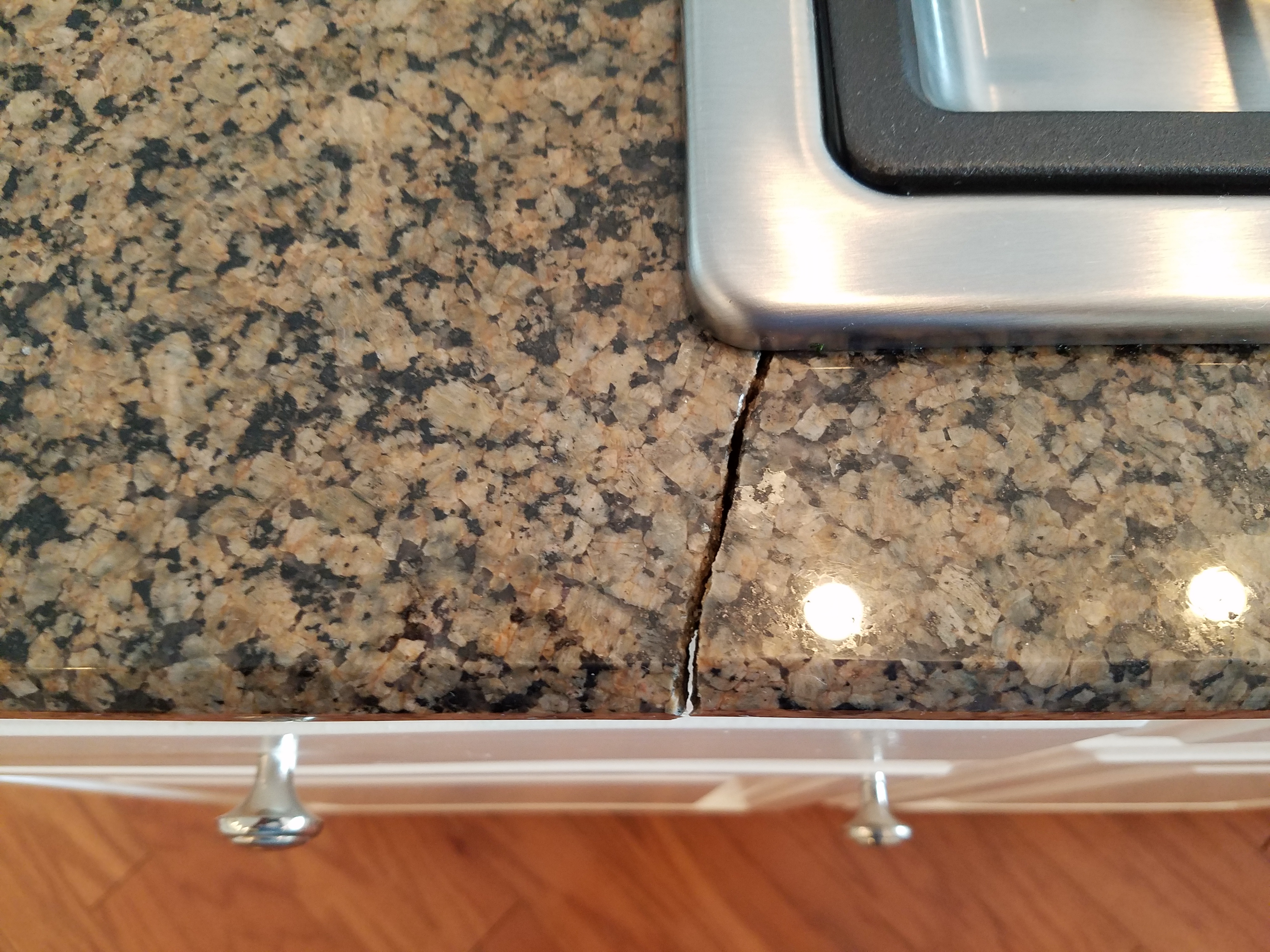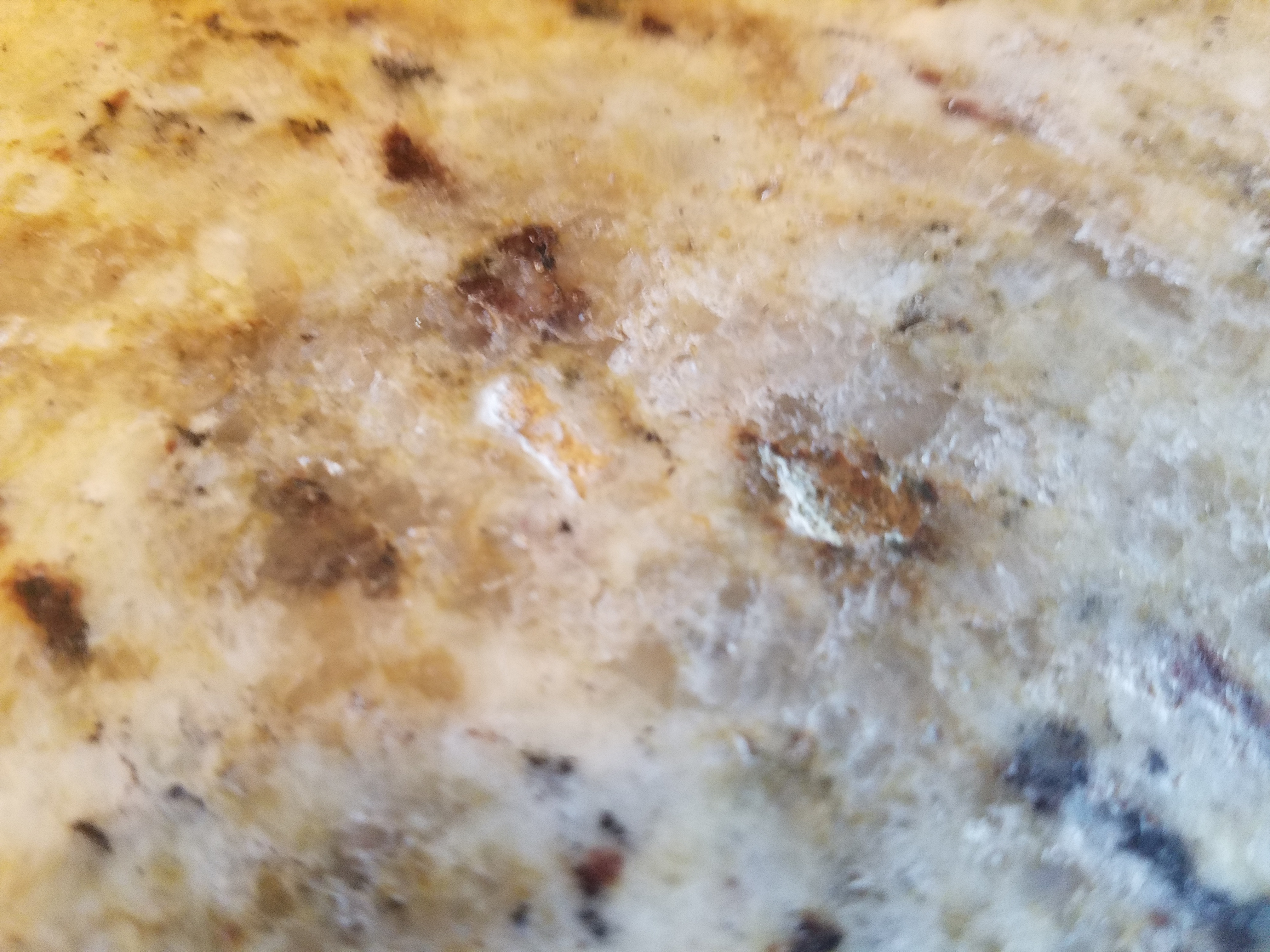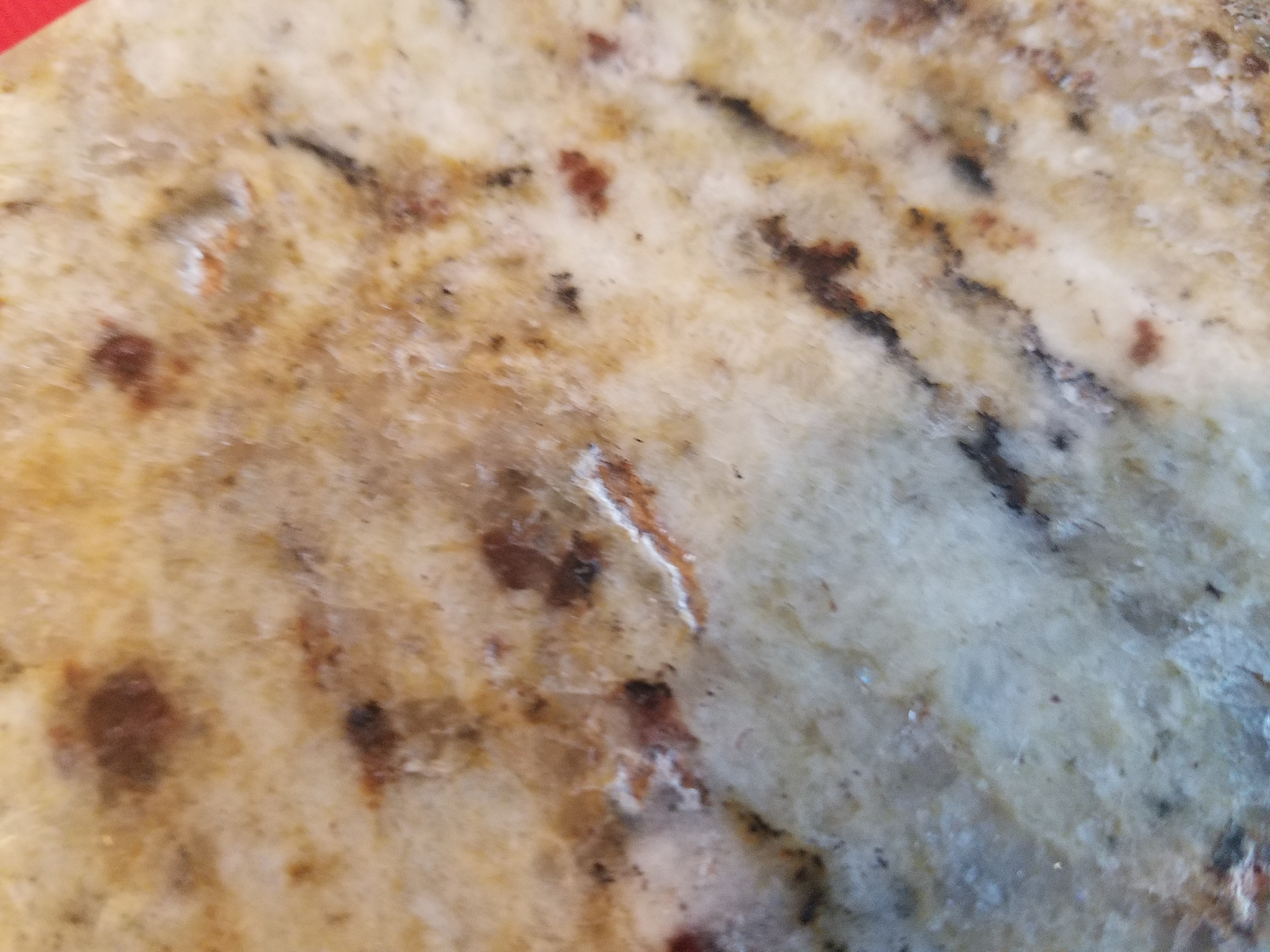Natural Stone Stain Removal Guide
See 'Cleaning Natural Stone' before using this guide. ACNE CREAMS Type Most of acne creams contain Benzol Peroxide which is a bleaching agent. Problem Acne creams which contain dyes can cause staining. These dyes are usually flesh to brown in color. Solution 1. Thoroughly clean the area with water and a soap (a mild detergent). 2. Once the area has dried, take some acetone on a clean white rag and rub the stained area. 3. If the acetone doesn't work poultice the area with a poultice powder and 30-50% hydrogen Peroxide.
ADHESIVES
Type Tape residue, cellophane, band-aids, stickers, etc. Problem Sticky residue on surface of stone. Some tape residues, especially duct tape can penetrate below the surface of the stone and can be very difficult to remove. Solution 1. Peel off any remaining tape, use a very sharp razor blade and be careful not to scratch the surface of the stone. 2. The remaining sticky residue can usually be removed with a rag and acetone. Pour the acetone on a clean white rag and rub the area until all of the sticky residue is gone. 3. If the adhesive has left a stain than prepare a poultice of diatomaceous earth or similar powder with one of the following solvents: *Mineral spirits *Toluene *Xylene *Methylene chloride
ALUMINUIM
Type Aluminum usually from windows, awnings ect. Problem Leaves a crusty white residue. Solution 1. Scrap any crusty residue from surface with a sharp razor blade on polished surface. On textured surfaces use a hard brush. 2. On textured surfaces mix one part hydrochloric acid in 20 parts water and apply solution and agitate with a soft nylon brush. 3. On polished surfaces dilute one part hydrochloric acid in 40 parts water. Apply solution and agitate with a soft nylon brush. Re-hone and polish the surface to return the luster.
Be extremely careful with hydrochloric acids near marbles they will severely etch damage the surface.
BEER
Type
There are literally hundreds of beers. The beer that seems to be more of a problem with stain is the dark beers. Light colored countertops are very susceptible to dark beer staining.
Problem
Sugars and proteins in the beer can cause a very dark stain on light colored stones.
Solution
1. Clean the entire area thoroughly with water and a mild detergent (dish washing soap like ‘Dawn’ works well). Allow the water and soap to soak into the stone for several minutes. Lightly agitate the area and remove excess water with a dry towel. Rinse the area with clear water.
2. If the above cleaning procedure does not remove the beer stain than try a stronger cleaner such as ammonia and water.
3. If the stone is still stained prepare a powder poultice with 30-50 % hydrogen Peroxide.
Several poultices may need to be applied.
BLEACH
Type
Common household bleach, Clorox, soft scrub with bleach, mildew killer like X-14 and similar brands.
Problem
Bleach contains sodium hypochlorite, which can etch soft marbles. It may also lighten certain sedimentary type stones like shell stone and coquina. Some black granites that have been dyed may lose color when exposed to strong bleach.
Solution
1. Flood the area with clean water to remove any excess bleach.
2. If the stone is etched then polish the area with a polishing powder such as aluminum oxide and oxalic acid. I recommend using a packaged powder. Apply a small amount of powder add some water and rub the area into a slurry with a white buffing pad.
3. If the stone has lighten there is very little that can be done. An application of color enhancer may cosmetically darken the area to help hide the discoloration.
BLOOD
Type
Human and animal blood, raw meats prepared on a marble countertop can cause blood staining.
Problem
Blood contains salts and proteins. If cleaned while still fresh it will usually not stain. If allowed to dry blood stains can be very difficult to remove.
Solution
1. Clean area thoroughly with cold water and a mild detergent (Dawn dish soap works well).
2. Prepare a solution of 50% household ammonia and water. Apply this solution and allow it to dwell for several minutes. Gently scrub the area and rinse with cold clear water.
3. If stain is still present poultice with a powder like diatomaceous earth and ammonia.
BODY FLUIDS
Type
Urine and vomit.
Problem
Urine and vomit contain acids which can etch polished marble. The proteins contained can also stain the stone and have a terrible odor.
Solution
1. Try to clean up the accident as quickly as possible .Blot the area with a clean white cloth.
2. Apply a solution of 1 part vinegar, 1 part 35% hydrogen peroxide and 6 parts water. Let solution soak into stain for several minutes and pick up with a wet vacuum.
3. After treatment above apply a solution of a commercial bacteria/ enzyme digesting agent (available at janitorial supply) Cover with a paper towel soaked with digesting agent. Allow to sit overnight. This should remove the odor. It may require several application s of digesting agent to remove the odor.
CANDY- NON CHOCOLATE
Type
Hundreds of types of candies-All containing sugar and various dyes.
Problem
Several candy types contain a dyes, especially red dye can be very difficult to remove.
Solution
1. Scrap remaining candy from surface.
2. Clean area with acetone and a clean white cloth.
3. If acetone doesn't work than poultice with powder like diatomaceous earth with one of the following solvents:
Mineral spirits
Toluene
Xylene
Methylene Chloride
CARPET PADDING
Type
Carpet padding made of jute.
Problem
Carpet that have jute backing can leave a difficult to remove brown to yellow stain on stone surfaces. The jute is made of a burlap type material.
Solution
1. Scrap any excess carpet padding from the surface.
2 .Clean area thoroughly with a good detergent (Ivory or stone soap) and clean cold water.
3 .Poultice with 20-50% hydrogen peroxide and poultice powder.
Jute backing can cause some very deep stains that can penetrate throughout the stone.
CHOCOLATE
Type
Candy, cocoa, ice cream.
Problem
Chocolate can leave brown stains in light color marbles.
Solution
1. Clean area thoroughly with cold water and a good detergent (Dawn dish soap works well).
2. If the stain is still present clean with ammonia and water. Let solution sit on stained area for several minutes. Remove excess solution and rinse with clear cold water.
3. If above procedures fail, poultice with Diatomaceous earth or similar powder and ammonia. Difficult to remove chocolate stains may require a poultice with 20-50% hydrogen peroxide.
COFFEE/TEA
Type
Instant coffee, hot tea and iced tea
Problem
Coffee and tea both contain tannin which can leave a yellow to brown stain. If left on stone long enough the stain can penetrate deep and be nearly impossible to remove. If the concentration of coffee or tea is strong enough it can also etch the surface of polished marble. Solution 1. Pour 35% hydrogen peroxide directly on the stain and add a few drops of ammonia. Leave until bubbling stops. Do not use ammonia only. Ammonia can permanently s set the stain. 2. If the above procedure does not remove stain then poultice with powder and 35% hydrogen peroxide. 3. If all else fails try a poultice with Toluene or Xylene.
COPPER
Type
Copper piping, sculptures, etc.
Problem
Copper can cause a green stain that can sometimes penetrate deep into stone if allowed to age.
Solution
1. Remove any excess crust by scraping with a sharp razor blade. If the surface is polished wet the surface with soap and water to prevent scratching the stone.
2. Prepare a solution of one part ammonium and 3 parts warm water. Apply this solution to the surface and agitate with a soft bristle brush. Rinse with clean water.
3. If stain is still present poultice with Ammonium Chloride and poultice powder. Ammonium Chloride based cleaners are available from chemical supply co.
EGG
Type
Chicken, duck or quail.
Problem
Eggs contains a protein called albumin which can leave a yellow stain.
Solution
1. Clean area thoroughly with cold water and detergent (Dawn dish soap or a commercial stone soap).
Do not use hot water, it can set the stain.
2. If stain still remains poultice with poultice powder and 20-50% hydrogen peroxide.
FATTY OILS
Type
Butter, margarine, fried foods, mayonnaise, salad dressings, gravy, etc.
Problem
Fats and oils can leave a dark stain which can be difficult to remove. Some salad dressings and foods contain dyes which can also cause staining.
Solution
1. Thoroughly clean stained area with cold water and a good detergent (Dawn dish soap or stone soap).
2. Apply a commercial grease remover to the stained area and let sit for several minutes. Remove excess degreaser and rinse with clean clear water.
3. If stain is still present, poultice with a commercial grease remover and poultice powder.
4. Stubborn stains can be removed with a poultice with a solvent such as toluene and poultice powder.
FRUIT JUICE (LIGHT)
Type
Apples, pears, oranges, lemon, lime, grapefruit juices.
Problem
Acids in some fruits, especially lemon will etch polished marble. The sugars in these fruits will turn yellow or brown if they dwell too long.
Solution
1. If the surface is etched, re-polish using a commercial available polishing powder. If the etch is very deep, re-honing may be necessary.
2. If the fruit has left a stain than clean the area with cold water and a good detergent (Dawn dish soap or a stone Soap).
3. If stain still remains, apply a poultice powder and 20-50% hydrogen peroxide.
FRUIT (RED)
Type
Cherry, grape, blueberry, blackberry, cranberry, raspberry, strawberry and there juices.
Problem
Fruits contain dyes which can be very difficult to remove.
Solution
1. Clean area with cold water. Do not use soap, it can set the stain.
2. If stain still remains, poultice with 20% hydrogen peroxide and poultice powder.
3. If stain is still not removed, poultice with toluene and poultice powder.
FURNITURE POLISH
Type
Spray and liquid furniture polishes
Problem
Oils, dyes, waxes and silicones can cause staining. The darker polishes (walnut) can permanently stain the stone.
Solution
1. Clean with acetone and a clean white rag. Allow acetone to sit on stain area a few minutes and blot remaining acetone with a clean rag.
2. If stain is still present poultice with one of the following solvents in poultice powder
*mineral spirits
*toluene
*Xylene
Methylene Chloride
GLUE SYNTHETIC
Type
Super glue, hot glue, epoxy resin, plastic model cement.
Problem
Glues will rarely stain. The glues are usually hard to remove from the surface.
Solution
1.On smooth surface scrap glue with a sharp razor blade. Be careful not to scrape scratch the surface.
2. Any remaining residue can be cleaned with acetone and a clean white rag.
3. If glue is real stubborn soak the area with acetone for several minutes and try scraping with a razor blade followed by wiping with acetone.
GLUE WATER SOLUBLE
Type
Casein, Elmer’s, mucilage, paste and hide glue.
Problem
White and clear glue rarely stain, however some of the darker glues can leave a stain that can be difficult to remove.
Solution
1. Scrap excess glue with a sharp razor blade .Be careful not to scratch the surface.
2. Clean with cold water and a good detergent (Dawn dish soap or stone soap). Try using a green scouring pad.
3. If glue is stubborn use acetone and a clean white rag.
4. If glue has left a stain than poultice with toluene or similar solvent and poultice powder.
GRASS
Type
Lawn grass and field or pasture grass.
Problem
Tannin and chlorophyll in the grass can leave a nasty green or yellow stain.
Solution
1.Clean stained area with a clean white rag and denatured alcohol.
2. If stain still remains poultice with 20-59% hydrogen peroxide and poultice powder.
Do not use ammonia or any alkaline cleaners on grass stains as it can permanently set the stain.
GREASE
Type
Petroleum grease like wheel bearing grease, cooking grease (Crisco) and vegetable oils, etc.
Problem
Grease leaves a nasty dark stain that can penetrate deeply into the stone. Grease can be very difficult to remove. Try to remove as soon as grease is spilled.
Solution
1. Clean area thoroughly with cold water and a good stone soap.
2. Soak stained area with a commercial grease remover for several minutes. If grease remover solution dries, reapply keeping it wet. Remove excess grease remover and rinse with clear water.
3. If stain is still present poultice with commercial grease remover and poultice powder.
4. For stubborn grease stains poultice with toluene or methylene chloride and poultice powder.
GUM
Type
Chewing gum, tree gum (sap), etc.
Problem
Gum rarely stains stone surfaces but can be very difficult to remove from honed and rough textures surfaces.
Solution
1. Do not try to scrap gum off surface, this only makes more of a mess. Freeze the gum using an aerosol gum freeze, available at most janitorial supply houses. Spray the gum for several seconds then chip the gum with a scrapper or putty knife. This should remove most of the gum.
2. If there is any gum residue still remaining apply a solvent cleaner such as a dry spotter, also available at most janitorial supply houses.
HARD WATER DEPOSITS AND STAINS
Type
Water stains from irrigation systems, faucets, bathroom fixtures, shower walls, etc.
Problem
Minerals in water will leave deposits which can appear as a white haze to large deposits of crust like minerals.
Solution
1. If deposits are large try scrapping off excess deposits with a sharp razor blade.
2. Next apply a solution of weak phosphoric acid and agitate the area applying more acid as needed. This will etch all marble surfaces so plan on re-finishing the marble.
3. Re-hone and polish the stone if necessary.
Some mineral deposits will be bedded below the surface of the stone and may cause spalling.
HEEL MARKS
Type
Black rubber and neoprene.
Problem
Heel marks leave a black streak mark on surface of stone. Rarely this stains but can be difficult to remove on rough textured stones and concrete.
Solution
1. Clean with acetone and a white rag. On textured stone try using a green scrub pad with acetone.
2. If acetone doesn't work try another solvent such as dry spotter, available at janitorial supply.
ICE CREAM - NON CHOCOLATE
Type
All except chocolate, see chocolate.
Problem
Food coloring and fruits can cause staining.
Solution
1. Clean area thoroughly with cold water and a good detergent (Dawn dish soap or Stone soap).
2. If stain still remains, poultice with 20-50% hydrogen peroxide and poultice powder.
3. If stain is real stubborn, try a poultice with toluene or similar solvent and poultice powder.
INK
Type
Ball point pens, magic markers, carbon paper, newspaper print, etc.
Problem
Most inks penetrate deep into the stone and can be very difficult to nearly impossible to remove, depending on the age of the stain. It is very important to get to the stain as quickly as possible.
Solution
1. Clean the area thoroughly with acetone and a clean white rag.
2. Poultice the stain with a solvent such as toluene or methylene chloride.
Several attempts will be necessary to remove stain .If no improvement is noticed after 5 attempts than stain is most likely permanent.
IODINE
Type
Iodine, mercurochrome and similar dyes found in medicines. Problem Iodine can leave a stain that can be nearly impossible to remove. Solution 1. Blot any wet iodine with a clean white rag. 2. Clean the area with denatured alcohol and a clean white rag. Be sure to blot the area. Do not wipe, this will only make the stain larger. Blot until you see no more dye on the white rag. 3. If stain still remains poultice with denatured alcohol and diatomaceous earth or similar poultice powder.
JAM OR JELLY
Type
Artificial and natural preserves etc.
Problem
Dyes and fruits can cause staining, especially grape and berry jams and jellies.
Solution
1. Clean area thoroughly with cold water and a good detergent (Dawn dish soap or stone soap).
2. If stain still remains poultice with a toluene or equivalent solvent and poultice powder.
KOOLAID
Type
KoolAid fruit drinks and popsicles, etc.
Problem
Dyes can be real difficult to remove, especially the red and orange types.
Solution
1. Clean the stain with a solution with ammonia and water. This will help neutralize the dye.
2. Poultice with commercial KoolAid remover, available at janitorial supply and poultice powder and KoolAid removers such as Kool Off, Red Out and Stain Away work well.
LEATHER
Type
Shoe and clothing leather.
Problem
Leather contains oils and dyes which can penetrate into stone and cause staining.
Solution
1. Clean the area thoroughly with acetone and a clean white cloth.
2. If stain is deep poultice with a solvent (toluene) and poultice powder.
LIPSTICK
Type
All colors and types.
Problem
Oil waxes and dyes can be difficult to remove.
Solution
1. Scrap excess lipstick with a sharp razor blade, Lipstick is very concentrated, attempting to clean without scraping excess will only spread the lipstick around.
2. Once all excess is removed clean with acetone and a clean white rag.
3. If stain is still present poultice with a solvent such as toluene and poultice powder.
LIQUOR
Type
Mixed drinks and white wine. Problem Alcohols can melt agglomerate* type stones. Dyes can cause staining. Solution Agglomerate stones that are damaged can sometimes be filled with a polyester resin. Seek professional help if this is the case or replace the stone. Stains will need a poultice with a solvent such as toluene and a powder poultice.
LOTION
Type
Baby lotion, body, suntan and hair oil, etc.
Problem
Lotions contain various oils which can cause dark staining. This can be difficult to remove if left on too long.
Solution
1. Thoroughly clean area with water and a good detergent (Dawn dish soap or Stone Soap).
2. Prepare a solution of a commercial grease remover and water. Apply solution to the stained area and let sit for several minutes. Agitate and remove excess solution and rinse with cold clear water. Repeat several times.
3. If stain is deep apply a poultice of Commercial grease remover and poultice powder.
MAKE-UP
Type
Mascara, blush, eye shadow, liquid foundation, etc.
Problem
Dyes, waxes and oils can stain stone. A lot of makeup has a high concentration of dye, which can be tricky to remove.
Solution
1.Remove any excess makeup, by blotting with a clean white rag. Do not wipe, this will only spread the stain wider.
2. Clean the stained area with denatured alcohol and a clean white cloth. Blot. Do not wipe.
3. If stain still remains than poultice with 20-59% hydrogen peroxide and poultice powder.
4. If stain still remains, poultice with a solvent like Toluene and poultice powder.
MILDEW
Type Mildew, fungus, algae and other living plant stains. Problem They can leave a black, green, blue, orange or white blotchy type stain on stone surfaces. Since this is a ling fungus it can grow and spread at a rapid rate. Usually requires a moist environment to grow, showers etc. Solution 1. Clean area thoroughly with a good detergent (dish or stone soap. 2. If there is any soap film on a shower wall for example, be sure to remove the soap film by scrapping than wiping with a clean rag and acetone. 3. To remove the mildew spray the area with a solution of 3 parts household bleach one part water and several drops of dish detergent. Continue to mist the area until all the mildew disappears. 4. Rinse the entire area with clean water and dry.
MILK
Type
Milk, ice cream and other milk products.
Problem
Animal fat contained in milk can sour and leave a yellow stain and also it can smell real bad.
Solution
1. Clean area thoroughly with a good detergent (Dawn dish soap or a stone soap).
2. Apply a solution of 3 parts bleach to one part water. Let stand for several minutes than rinse with clean water.
3. If stain is still present poultice with 20% hydrogen peroxide and poultice powder.
MORTAR
Type
Concrete, thin set, mud sets, grout films and other concrete based residues.
Problem
Mortar can leave a film on surface of stone that can be hard to remove. Very rarely will concrete stain unless they are colored.
Solution
1.If the film is light, clean the surface of the stone with a heavy duty stone cleaner and water (Heavy Duty cleaners are available from stone care suppliers-see supplier list in appendix).
2. If film is stubborn clean the surface with a solution of one part hydrochloric acid to 20 parts water on textured stone and one part hydrochloric acid to 40 parts water on polished stone. Agitate until mortar is removed.
3. Re-hone and re-polish marble surfaces.
Caution: Hydrochloric acid can severely etch polished marble use extreme caution.
MUD Type Clay, red dirt, other Problem Dirt is a not a big problem, however red clay can leave some nasty stains that can be difficult to remove. Solution 1. Clean area thoroughly with a good detergent (dish soap or stone soap) and plenty of cold water. This should remove all surface dirt. 2. If dirt has left any stains than poultice with household ammonia and poultice powder. 3. If the stain was caused by red clay and the ammonia does not remove it than poultice with a mixture of one part laundry detergent and 2 parts poultice powder.
MUSTARD
Type
All types
Problem
Mustard contains Turmeric, which is a yellow spice that causes the yellow staining. Mustard stains can be very difficult to remove, especially if the stain is old.
Solution
1. Thoroughly clean the stained area with cold water and a good detergent (Dawn dish soap or Stone Soap). Blot only.
2. Pour 20-50% hydrogen peroxide directly on the stain and add a few drops of ammonia. Leave until bubbling stops.
3. If the stain is still present poultice with 20-50% hydrogen peroxide and poultice powder.
Do not use ammonia or alkaline type cleaners on mustard stains because this can set the stain.
NAIL POLISH
Type
Enamel or lacquer types.
Problem
Nail polishes will dry very quickly. For this reason the dyes it contains will rarely penetrate into polished stone. Rough texture stone is another problem, the nail polish will penetrate immediately causing a difficult to remove stain.
Solution
1. Immediately blot with a clean white cloth.
2. Apply acetone to the stain and blot with a clean white cloth. Continue to apply acetone and blot until stain disappears.
3. If stain is old, poultice with a solvent (Toluene, alcohol, etc.) and a poultice powder such as diatomaceous earth.
OIL
Type
Automotive, cooking and lubricating, etc.
Problem
Oil can be very difficult to remove on most stone. Oils will penetrate deep into the stone and will spread out throughout the stone. Try to clean up the oil spill as soon as it happens.
Solution
1. Blot up any excess oil with a clean white cloth. If oil has dried on the surface scrape with a sharp razor.
2. If oil is still fresh and has penetrated into the stone sprinkle a generous portion of dry poultice powder on the spill and let stand for 12-24 hours.
3. Remove the dry poultice and prepare a solution of commercial grease remover and water. Apply this solution to the spill and keep it wet for 30 minutes. Vacuum the solution up and blot the remainder with a clean white cloth.
4. If stain is still present poultice with a solvent (Methylene chloride works best) and a poultice powder like diatomaceous earth.
PAINT - OIL BASED
Type
Oil based paints and alkyd resins and solvents.
Problem
Oil based paints are the most difficult paints to remove .The oils and solvents contained in these paints will carry the dyes deep into the stone.
Solution
1. Immediately blot any excess paint from the surface with a clean white cloth.
2. Apply liberal amounts of mineral spirits (paint thinner) to the spill and blot. Continue to blot until no color is observed on the cloth.
3. Apply a poultice of methylene chloride or a commercial paint remover and a poultice powder.
PAINT - WATER BASED
Type
Water based paints and polymer resins.
Problem
Not as difficult to remove as oil based paints but can still cause serve headaches trying to remove.
Solution
1. If the spill is fresh, blot immediately with a clean white cloth.
2. Clean area with water and a good detergent (Dawn dish or Stone Soap).
3. If stain is dry, scrap paint with a sharp razor blade. If scraping is difficult apply a solution of soap and water to the spill and scrap while wet.
4. If stain has penetrated the stone, poultice with a commercial water rinse able paint remover and poultice powder.
PAPER
Type
Brown paper bags and construction paper.
Problem
It is very common for contractors to cover a new stone floor with brown construction paper. If this paper gets wet or slightly wet it will bleed into to stone leaving an ugly brown stain.
Solution
1. Clean area with acetone and a clean white cloth.
2. Poultice area with a solvent (Mineral Spirits or toluene) and poultice powder.
PENCIL
Type
Graphite and indelible pencil.
Problem
Pencil can be tricky to remove since the graphic may penetrate into the stone. Commonly the pencil is only on the surface of the stone.
Solution
1. Try taking a pencil eraser and erasing the pencil. This procedure works almost 90% of the time.
2. If pencil mark has penetrated the stone poultice with denatured alcohol and poultice powder
PERFUME
Type
Oils, alcohol and fragrances.
Problem
Oils can penetrate the stone and cause a light oil spot. Alcohols can also react with certain stones and turn a brown color.
Solution
1. Clean area thoroughly with denatured alcohol and a clean white cloth.
2. If stain is deep poultice with denatured alcohol and poultice powder.
PERSPIRATION
Type
Body oils, salts and enzymes.
Problem
Oils from perspiration are a big problem on walls, countertops etc where hands are constantly touching the surface of the stone.
Solution
1. Blot the area with Denatured alcohol and a clean white cloth.
2. If stain is still present poultice with denatured alcohol and poultice powder.
RUBBER
Type
Tire marks created by cars, trucks, carts, etc.
Problem
Tires can leave a rubber track on surface. Rarely will tire marks stain but they can be difficult to remove on porous surfaces like concrete, brick and rough stone.
Solution
1.Clean thoroughly with a commercial grease remover (available at janitorial supply) and warm water. Scrub with stiff bristle brush.
2. If marks are stubborn clean with a solvent (mineral spirits or toluene). Use a stiff bristle brush.
RUST
Type
Iron oxide
Problem
Rust is one of the most difficult stains to remove. It can cause a reddish-brown to yellow stain that can permanently set into the stone.
Solution
1. If the rust is new try apply a solution of "Iron-Out" (available at home centers) and water. Mix into a slurry and lightly agitate the area with a soft bristle brush. Rinse with clear water.
This product may cause etching, be prepared to re-polish.
2. Use a paste from 'Alpha' called 'RSR2000'. It will turn purple as it reacts and needs to be removed quickly or the rust turned purple will have to be removed with hydrogen peroxide. This method does not etch the stone
3. If stain is old and has penetrated into the stone poultice with Iron Out and poultice powder.
Do not use clay powders, use diatomaceous earth.
Never use bleach, it will only make stain worst.
SOAP FILM
Type
Soap film on shower walls and vanity tops.
Problem
Soap from showers can build up on shower walls leaving a film that will not wash off with regular cleaning.
Solution
1. If soap film is thick, scrap with a razor blade. Wet the surface to avoid scratching the surface.
2. Once all heavy build-up is removed clean with acetone and a green scrub pad.
3. There are also commercial soap film removers on the market which work well, but be careful that they do not contain acids which can etch polished marble.
Several poultices may need to be applied to completely remove all stain
SHOE POLISH
Type
Liquid polishes including white.
Problem
Dyes in shoe polish can penetrate the stone leaving a nasty stain.
Solution
1. If dry, scrap excess polish with a clean sharp razor. Apply as a solution of stone soap to help lubricate the blade to prevent scratching.
2. Clean the area thoroughly with acetone and a clean white cloth.
3. If stain still appears poultice with a solvent (Toluene, etc) and a poultice powder.
SILICON
Type
Silicon caulking used for grouting and anchoring stone.
Problem
May be a serious problem when caulking is used to help hold anchors in place on stone wall panels. The silicone will start to bleed through the stone in the area were the anchors are. It may take several months before the silicon becomes viable.
Solution
The only known technique that will remove this silicon staining is the following:
Prepare a poultice with methylene chloride (Commercial paint remover) and a powdered poultice. May require a dozen applications.
If the silicon has not completely cured the staining may return again.
SMOKE/SOOT
Type
Smoke and soot from fireplaces and fire damage, not including tobacco smoke.
Problem
Smoke and soot contain particles of oil and carbon which can leave a black ugly mess.
Solution
1. Wipe excess soot with a clean, dry white cloth.
2. Clean area thoroughly with a solution of stone soap or dish washing soap in warm water. Use a stiff brittle brush for rough textured stone or concrete.
3. If smoke damage is heavy clean with a solution of commercial grease remover (available at janitorial supply) and warm water.
4. If smoke damage is still present poultice with the commercial grease remover and poultice powder.
SOFT DRINKS
Type Coke, Pepsi and all other carbonated sodas. Problem Coloring and sugars in sodas can cause severe staining. Solution 1. If the spill is fresh blot with a clean white cloth 2. Clean the area thoroughly with a good detergent (dish soap or stone soap) with warm water. Flood the stained area thoroughly. 3. If stain is still present poultice with 20-50% hydrogen peroxide and poultice powder.
SOUP
Type
Soups and stew containing meat and vegetables.
Problem
Soup can leave some greasy looking stains that can be difficult to remove, especially if the stain is old.
Solution
1. Clean the area thoroughly with a solution of ammonia and water.
2. If stained after clean-up poultice with ammonia and poultice powder.
3. If the stain is present poultice with 20-59% hydrogen peroxide and poultice powder.
SOY/WORCESTERSHIRE SAUCE
Type
Soy and Worcestershire sauces.
Problem
Coloring and proteins in these sauces can be extremely difficult to remove.
Solution
1. Clean the area thoroughly with acetone and a clean white cloth. Be sure to blot only.
2. Poultice with a solvent Toluene and a poultice powder.
STREAKING
Type
Streaking appears as a cloudy uneven pattern on the surface.
Problem
Streaking can be caused from the following:
- Dirty mops used to mop floor.
- Improper application of waxes and coatings.
- Improper cleaners.
- Too much cleaner.
Solution
1.Determine what is causing the streaking and eliminate the cause.
2 .If streaking is caused by wax build-up, strip the surface with a commercial wax stripper (available at janitorial supply).
3. If streaking is caused by too much cleaner, dirty mop or improper cleaner, re-mop the floor with stone soap and buff with a white nylon pad.
SYRUP
Type
Honey, molasses, maple and corn syrup.
Problem
Sugar and coloring added to these syrups can cause staining.
Solution
1. Thoroughly clean stained area with cold water and a good detergent (Dawn dish soap or Stone Soap).
2. If stain still remains clean with ammonia and water. Let solution sit for several minutes, agitate and rinse with clean water.
3. If the stain is still present poultice with 20-50% hydrogen peroxide and poultice powder.
TAR
Type
Asphalt, roofing tar, beach tar, etc.
Problem
dyes in tar can cause deep staining in stone and concrete.
Solution
1. Scrap away any excess tar with a clean dry razor blade.
2. Clean the remaining tar with acetone and a clean white cloth.
3. If stain still remains poultice with mineral spirits (paint thinner) and poultice powder.
4. If stain is stubborn poultice with De-Solve-it (available at hardware stores) and poultice powder.
Do not use water with tar. It will harden the tar and set the stain.
TOBACCO
Type
Smoke stains from cigarettes, cigars and even that wacky weed.
Problem:
Nicotine can cause a light yellow stain that can be difficult to remove.
Solution
1. Clean area thoroughly with a good detergent (Dawn dish soap and Stone Soap) and cold water.
2. For heavy tobacco stains clean with a commercial grease remover and cold water.
3. If stain still remains poultice with commercial grease remover and poultice powder.
TOMATO
Type
Canned fresh tomatoes, tomato pastes, juice etc.
Problem
Acids in tomato products can etch the surface of polished marble. Also this can leave a red stain in porous stones.
Solution
1. Clean area thoroughly with cold water and a good detergent (Dawn dish soap or stone Soap).Rinse with clear water.
2. If stone is stained poultice with 20-50% hydrogen peroxide and poultice powder.
3. If stone is etched re-polish with polishing powder.
TOMATO SAUCE
Type
Barbecue, steak, spaghetti and catsup.
Problem
Tomato sauces contain tannin, oils and dyes. The dyes will leave a red to brown stain. The oil will penetrate the stone and darken.
Solution
1.Clean area thoroughly with cold water and a good detergent (Dawn dish soap works well).
2. If stain is still present clean the area with an alkaline grease remover (Commercial grease removers are available at most janitorial supply houses). Mix with water according to directions and let solution stand on stained area for several minutes. Agitate with a cloth and rinse with clean water.
3. If stain is still not removed then poultice with powder (diatomaceous earth or similar powder) and an alkaline grease remover. A second poultice may be required using powder and a solvent such as toluene or methylene chloride if there is dye present.
VEGETABLE
Type
Green and yellow vegetables.
Problem
Vegetables can leave a green yellow stain.
Solution
1. Clean area thoroughly with a good detergent (Dawn dish or Stone Soap) and cold water.
2. If stain is still present poultice with 20-50% hydrogen peroxide and poultice powder.
VOMIT
Type
Human and animal vomit.
Problem
The acids in the stomach have a very low acidic pH and can severely etch the surface of polished marble. Also vomit can leave a stain depending on what was eaten.
Solution
1. Clean area through with a good detergent (Dawn dish soap or Stone Soap) and cold water.
2. Clean are with a solution of household ammonia and cold water. Contain to clean until all stain is gone.
3. If stain is still present apply a poultice of ammonia and poultice powder.
4. If odor is still present apply a solution of enzyme digesting agent (available at janitorial supply). Keep wet for several hours. Covering with a wet paper towel will help keep enzyme solution wet.
5. If stone is etched polish with polishing powder.
WATER RINGS/SPOTS
Type
Rings from drinking glasses and hard water spots from drips.
Problem
Water will not usually stain but will leave a white ring or spot. This ring or spot is deposits of minerals from the water. If the drink contains acid (lemon in ice tea) it will etch polished marble in the shape of a ring or spot.
Solution
1. Try buffing ring or spot with dry #000 steel wool.
2. If ring or spot still remains re-polish with polishing powder.
3. If ring or spot is very deep re-honing may be necessary.
If the stone has been waxed or colored with dyes the ring may have cleaned the wax or dyes from the surface. To test for waxes or dyes take some acetone and clean an inconspicuous area. If the stone lightens than there is a wax or dye on the stone. If this is the case you will need to re-wax or re-dye.
WAX COATINGS
Type
Waxes, acrylics, urethane, epoxy, etc.
Problem
Waxes can yellow and give a plastic like appearance. They will also attract dirt.
Solution
1. If the coating is water based (Acrylics), strip the stone with a commercial wax stripper (available at janitorial supply). Be sure to rinse thoroughly.
2. If the coating is solvent based (waxes, urethane, epoxy) Strip with a commercial paint stripper containing methylene chloride. There are also now available non methylene chloride stripper that work effectively on these materials.
3. Once all coatings have been stripped re-honing and re-polishing may be necessary.
WINES
Type
Red wines.
Problem
Tannin contained in red wine can severely stain stone.
Solution
1. Clean the area thoroughly with acetone and a clean white cloth.
Do not use detergent and water-this may set stain.
2. If stain is still present poultice with 20-50% hydrogen peroxide and poultice powder.
3. If stain is stubborn try a poultice with a solvent (Toluene) and poultice powder.
WOOD STAIN
Type
Solvent based stains and dyes.
Problem
Dyes contained in these stain can be nearly impossible to remove, after all there designed to stain wood. The old the stain gets the harder it is to remove.
Solution
1.Clean area thoroughly with acetone and a clean white cloth. Continue to clean until no stain is viable on rag.
2. Prepare a poultice with methylene chloride (Commercial Paint Stripper) and poultice powder. It may take several attempts to pull these difficult stains out.
Good luck this is a tough one.
POULTICES
WHAT IS A POULTICE?
A poultice is an absorbent material applied to a surface to draw out a stain. It can be a powder, paper or a gel. The most common poultices in use today are powders. A number of powders are very absorbent and are ideal for stain removal. Some typical powders used in poultices are the following:
clay and fullers earth
talc
chalk( whiting)
sepiolite ( hydrous magnesium silicate)
diatomaceous earth
methyl cellulose
flour
Clay and diatomaceous earth are usually the best. Do not use whiting or clay containing iron. When using acidic chemicals, the acids will react with the iron and may cause yellowing of certain stone surfaces. It is best to purchase poultice powder materials from a reputable supplier of products for this purpose. Some typical paper poultices are:
cotton balls
paper towels
gauze pads
Paper poultices can be quite effective on mild stains. They are easier to apply than powder poultices and are also easier to remove. Gel poultices are usually thick chemical gels that are designed to be applied to a stain with the use of powders or papers. They work effectively with certain stains. When purchasing poultice materials, ask if they contain stain removing chemicals or if they need chemicals added. Some powder and gel poultices contain chemicals, and all you need to do is add water. Never mix additional chemicals with a poultice that contains its own chemical formulation.}
APPLYING A POULTICE
Soon as the stain is identified, the following steps can be followed.
1. Identify the stain.
2. Clean the stained area to remove excess from the surface.
3. Wet the stained area with distilled water. Wetting fills the pores of the stone with water, isolating the stain and accelerating the removal by the chemical.
4. Prepare the poultice. If a powder is to be used, mix the powder and the chemical of choice into a thick paste, the consistency of peanut butter. In other words, wet it enough so that it does not run. If a paper poultice is to be used, soak the paper in the chemical. Lift the paper out of the chemical until it stops dripping.
5. Apply the poultice to the stain being careful not to spill any on the non-stained areas. Apply approximately one-quarter-inch thick overlapping the stain area by about one inch.
6. Cover the poultice with plastic (food wrap works great). Tape the plastic down to seal the edges. Allow the poultice to dry thoroughly. This is a very important step. The drying of the poultice is what pulls the stain from the stone into the poultice material. If the poultice is not allowed to dry, the stain may not be removed. Drying usually takes from 24 to 48 hours.
7. After 24 to 48 hours, remove the plastic.
8. Remove the poultice from the stain. Rinse with distilled water and buff dry with a soft cloth. If the stain is not removed, apply the poultice again. It may take up to five applications for difficult stains.
9. Some chemicals may etch the marble surface. If this occurs, then apply polishing powder and buff with a piece of burlap to restore the shine.
ALKALINE
Type
Etching from alkaline strippers, ammonia and heavy duty stone cleaners.
Problem
Alkaline etching is caused by alkaline salts contained in cleaners that are deposited below the surface of the stone. The etch marks appear similar to an acid etch mark.
Solution
1. Attempt to remove the etching with a mild acid. If the stone is a polished marble do not use acid.
2. If dealing with a polished marble re-hone and re-polish the etched area.
If the etch appears light try re-polishing only.
CRYSTALLIZATION
Type
Crystallization is a process used to polish marble. Includes all brands
Problem
When this process is overused it can buildup and turn yellow on light colored stones. It also may give the stone a plastic like look.
Currently this process is under great controversy and is being investigated and tested by the marble and stone care industry.
Solution
1. Crystallization can be stripped chemically using a solution of Oxalic acid and water. Start by using one cup of Oxalic acid to one gallon of water. Apply this solution to the stone and agitate with a hog hair pad.
2. Once coating is removed chemically, re-honing and polishing will be necessary.
3. The alternative method to chemical stripping is to simply grind the crystallization off, re-hone and re-polish
STUNS MARKS Type Stun marks caused by heavy objects doped on a marble floor, also high heel marks. Problem Stun marks are very common on some marbles, usually caused from woman walking across floor with high heels leaving a white spot on the marble. Stun marks can telegraph to the bottom of the stone. They are caused from the individual crystal in the stone exploding. Solution Try grinding, honing and polishing the floor. This may eliminate some light stuns but chances are they cannot be removed.
SWIRLS Type Circular pattern. Problem Swirl marks appear as circular patterns on the surface of the stone. Usually caused by a floor machine using abrasive pads like steel wool or pads that have trapped sand and grit under them. Solution Light swirls can be removed by re-polishing. Heavy swirls will require re-honing and re-polishing. Caution: When using any type of rotating machine (floor buffer, automatic scrubber and hand machine) never hold the machine still while running keep it moving. Keeping machine still may cause severe swirling.
WARPING OF GREEN MARBLE
There are several types of thin stone tiles are very susceptible to warping. Many of the green marbles and a few agglomerate marbles are notorious for this warping condition. Many of an installer have had the surprise to find that there tile installation has become warped overnight. Why does this a happen and can it be prevented. Warping is caused by water. Green marble set with any water based material will have a tendency to warp. The mechanism of why the tile warps is somewhat a mystery. Some believe that the water fills the pores of the stone and when the water evaporates the orientation of the stones crystal change and cause it to warp. Whatever the reason, one thing is for sure, green marble can warp when set with water based materials.
Cure: Once a green marble tile warps it is difficult to repair. Attempts have been made to grind the tile flat, but this usually fails since additional water is introduced during the grinding process. The green simply warps again.
Prevention: The only way to prevent warping is to install it properly with a non-water based material such as epoxy. Some installers have also been successful in sealing the back of the tile with epoxy and installing it in a water based system (see July Stone & tile Report). Do not attempt to seal the back of the tile with a silicone sealer. The silicone acts as a water repellent and will cause the setting material to fail resulting in a bond loss.
YELLOWING
Type
General yellowing across the surface of most stones, especially white marbles:
Problem
There are many causes for yellowing of stone: UV light can cause yellowing over time. Iron contained naturally in stone can oxidize and cause yellowing. Inexpensive coatings can cause yellowing. Mastic used to set stone can yellow.
Solution
1. If the yellowing is caused by iron contained naturally in the stone or the stone is aging-forget you will never get the yellowing out.
2. If the yellowing is caused by waxes or coating strip them off according to stripping directions (see waxes).
Yellowing of white marble is very common and cannot be reversed at this time.


